
by Polina Yan
AI avatars have moved far beyond cartoon filters and novelty apps. In 2025, they’re redefining how we present ourselves online — from personalized content on social media to branded spokespeople in marketing videos. Whether you’re an individual creator or part of a business team, a high-quality AI-generated avatar can act as your always-ready digital twin.
An AI avatar generator uses artificial intelligence to create lifelike representations of people — animated, still, or even interactive — based on photos, prompts, or style presets. And the quality? Better than ever. Advances in AI and visual processing have made it easier to generate avatars that feel expressive, realistic, and customizable.
The shift from simple filters to full-fledged digital selves isn’t just a visual upgrade. Analysts who study online identity point out that AI avatars are quickly becoming part of how people actually exist in virtual spaces.
“AI avatars are not just futuristic novelties—they are quickly becoming foundational elements of online identity in the metaverse and beyond.”
— Evelyne Hoffman, WINSS Solutions
This aligns with what we see in 2025: when you choose an AI avatar generator, you’re not just picking a fun effect. You’re choosing the engine behind your digital presence across social media, games, virtual meetings, and future metaverse platforms.
In this guide, we’ll help you find the best AI avatar generator for your needs — whether you’re looking for free tools, mobile apps, or advanced solutions that create avatars from scratch. Let’s dive into the tools shaping digital identity in 2025.
Top 7 AI Avatar Generators in 2025
| Tool | Best For | Strengths | Limitations |
|---|
| Synthesia | Professional video avatars | Talking avatars, multilingual voice, business-ready | Paid-only features, limited styling |
| MagicShot AI | Social media visuals | Huge style variety, easy to use | No video/animation, photo quality dependent |
| Fotor AI Avatar | Influencers & coaches | Beginner-friendly, solid headshots | Static images only |
| Picsart AI Avatar | Gen Z & casual creators | Fast, vibrant, mobile-first | Limited realism, subscription for full use |
| Ready Player Me | Gaming & VR | 3D full-body avatars, engine integration | Technical setup, fewer 2D options |
| Reface App | Viral animated content | Fun, animated avatars, free/low-cost | Not high-res, privacy concerns |
| Lensa AI | Artistic personal branding | Painterly, fantasy & Instagram-ready | Style packs can be pricey |
How We Chose These Generators

Selecting the best AI avatar generators is less about exceptionally high-quality graphics. From numerous dozen tools released annually, we focused on those aspects of highest value to users — whether you’re developing content to post to Instagram, making character assets to integrate into your game, or building a virtual representative of your business.
First and foremost, realism was at issue — just how realistic the avatars look and move. An advanced digital character needs to be immersive and never off-putting nor robotic. Other than that, diversity mattered. We wanted to have software where users can create avatars with different styles, body types, and moods.
Usability was paramount as well. Some websites don’t require any design experience at all, and others need you to have some level of technical know-how. We considered both options.
We balanced free versus paid features — not just what’s free, but whether or not paid tiers are worth it.
Finally, we looked at output quality. Does the generator produce still images, animated avatars, or video-ready content? Can the files be used across social media, YouTube, game engines, or enterprise platforms?
From creators to marketers to indie game devs — these tools have use far beyond novelty. So we picked solutions that truly deliver.
Top 7 AI Avatar Generators in 2025
Not all AI avatar tools are built the same. Some focus on hyper-realistic video avatars for business, others on stylized portraits for social media. Whether you want to make an AI avatar for your Twitch profile, marketing campaign, or personal brand, there’s a tool out there tailored to your needs.
We’ve tested and compared dozens of popular platforms and narrowed it down to seven that really stand out in 2025 — based on realism, features, ease of use, and the kind of content you can create. From polished video presenters to artsy cartoon styles, here’s our take on the best of the best.
Synthesia

If your goal is to create video avatars that actually talk — not just static profile pics — Synthesia is a strong contender. Originally built for corporate training and explainer videos, it’s now used by marketers, educators, and small business owners who want to replace on-camera filming with smart, polished AI presenters.
The process is simple: choose an avatar, type your script, and let the system turn it into a video with realistic lip-syncing. You can also clone your own voice and use your own avatar if you’re on a higher plan.
That straightforward workflow is exactly why tools like Synthesia became popular with training and marketing teams. Even the company’s own product messaging emphasizes how far AI avatars have come as a replacement for traditional video production.
“Produce studio-quality videos with AI avatars and voiceovers in 140+ languages. It’s as easy as making a slide deck.”
— Synthesia
This quote reinforces the use case you describe: Synthesia isn’t about fun profile pics — it’s about scalable, multilingual, business-ready video. In your review, it underlines why you put Synthesia at the “professional video avatar” end of the spectrum, compared to more casual selfie-style generators later in the article.
Strengths
- High-quality avatars with natural motion and expression
- Multilingual voice support
- Ideal for explainer videos, training content, and branded video messaging
Limitations
- Not great for casual users or creative expression — very business-focused
- Requires a paid plan for most features
- Limited customization of avatar appearance in lower tiers
Synthesia isn’t the best AI avatar app for selfies or fun — but it’s excellent if you need professional, video-ready avatars at scale. Think: onboarding videos, product walkthroughs, or educational content where you want a consistent, polished look.
MagicShot AI
MagicShot AI is built for people who want to create multiple versions of themselves — not just one perfect selfie. It’s especially popular with social media users, digital creators, and professionals looking to generate a wide range of stylized portraits for content and branding.
Upload a few photos, choose your styles, and the platform spits out dozens of unique AI-generated avatars: cartoon, cyberpunk, watercolor, anime, fashion editorial — you name it. It’s easy to use, and most results look polished enough to use as profile pictures, thumbnails, or promo visuals.
Strengths
- Huge variety of artistic styles
- Simple interface with no learning curve
- Great for creating eye-catching content fast
Limitations
- Mostly image-based — no video or animation support
- Not suited for professional business use (e.g., training videos)
- Best results require high-quality photo input
If you’re looking for the best AI avatar creator to experiment with different aesthetics or update your personal brand visuals, MagicShot AI is a fun, flexible option.
Fotor AI Avatar Generator
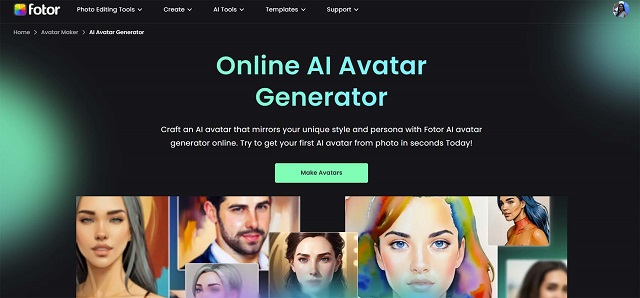
Fotor has been around as a photo editor for years, but its AI avatar generator has become a standout feature in 2025. It’s a great choice for anyone who wants quick, creative avatars without diving into complex tools or pricey subscriptions.
The Fotor AI Avatar Generator lets you generate dozens of avatars by uploading a few selfies — similar to Lensa or MagicShot — but with smoother output and better color harmony. It leans toward polished, semi-realistic styles with just enough flair to make your avatars pop on social media or websites.
Strengths
- Accessible to beginners
- Reliable output even with average-quality photos
- Includes editing tools to tweak results
Limitations
- Mostly focused on headshots
- Limited to static images
- Some features hidden behind a paywall
If you’re searching for the fotor AI avatar generator that balances speed, quality, and ease of use, this is an easy one to recommend — especially for influencers, coaches, and creators.
Picsart AI Avatar
If you’re already familiar with Picsart as a creative editing app, you’ll be glad to know its AI avatar generator online tool is just as intuitive. It’s geared toward casual creators, Gen Z users, and anyone who wants a personalized digital look for their socials without spending hours tweaking settings.
Upload a handful of selfies, and you’ll get back stylized avatar sets in various aesthetics — futuristic, dreamy, gritty, cartoonish. The avatars are clearly AI-generated, but that’s part of the appeal: they’re bold, vibrant, and perfect for platforms like TikTok, Instagram, or Discord.
Strengths
- Mobile-first, quick, and fun to use
- Great for personal branding and content creation
- Integrated with Picsart’s broader editing tools
Limitations
- Limited realism — not great for business use
- Subscription needed for full access
- May repeat certain looks if you don’t upload diverse photos
As an AI avatar generator online, Picsart hits the sweet spot for users who value speed, color, and content-ready visuals over ultra-precise realism.
Ready Player Me

Ready Player Me takes avatars into the world of 3D. If you’re building a virtual world, VR experience, or game — or just want a fully rigged 3D version of yourself — this is hands-down the best avatar generator in that space.
It’s especially popular among developers and game designers because of its wide compatibility with Unity, Unreal Engine, and WebXR. You start by uploading a selfie, and the platform creates a full-body avatar you can customize in style, outfit, and movement. It’s also used in virtual meetings, social VR platforms, and metaverse-style apps.
Strengths
- Generates ready-to-use 3D avatars
- Integrates well with development pipelines
- Ideal for gaming, VR, and interactive platforms
Limitations
- More technical than image-based avatar apps
- Requires understanding of game engines for full use
- Limited options if you’re looking for stylized 2D content
If you’re building for Web3, gaming, or immersive tech, this may be the best avatar generator for bringing your virtual self to life in real-time environments.
Reface App
Reface made a name for itself with real-time face-swapping and viral deepfake content, but its newer avatar tools have given it a fresh edge in 2025. If you’re after quick, animated, personality-filled avatars for memes, messages, or fun promos, this might be the best free AI avatar generator for you.
The app lets you create animated avatars that lip-sync, emote, and mimic expressions. It’s not meant for polished professional output — but that’s exactly why it works so well on platforms like TikTok, Snapchat, and Reels. It’s fast, weirdly accurate, and way more engaging than a still image.
Strengths
- Totally mobile, built for viral content
- Includes animated avatars and motion-based templates
- Many features are free or low-cost
Limitations
- Not business-oriented
- Output isn’t high-res enough for large-scale media use
- Data/privacy concerns with some users
If you’re focused on fun, humor, or storytelling, this is one of the best ways to experiment without spending a dime. For sheer personality, it’s a standout among the best free AI avatar generator options.
Lensa AI (by Prisma Labs)

Lensa exploded in popularity for its dreamy, highly stylized portraits — and its best AI avatar maker features in 2025 continue to deliver. It’s designed for people who want something more aesthetic than realistic: think painterly effects, fantasy themes, and Instagram-worthy images.
Upload 10–20 photos, choose a style pack, and get back dozens of variations. Some look cinematic, some lean into anime or fantasy, and others have that bold digital art vibe that works great for personal branding or content aesthetics.
Strengths
- High-quality, artistic results
- Super easy to use with a sleek mobile interface
- Beautiful filters and visual themes
Limitations
- No animation or video options
- Style packs can get expensive
- Output sometimes over-processes faces
As a best AI avatar maker, Lensa isn’t built for corporate needs — but it’s perfect if you want avatars that feel more like art than identity. Creators, freelancers, and influencers will find a lot to love here.
Custom-Built AI Avatar Generators: Scrile AI as Your Development Partner

Choosing the best AI avatar generator is great if you’re creating content for fun or personal branding. But what if your goal is bigger — launching your own product, offering avatar features in your app, or building something truly custom that no one else has? That’s where Scrile AI becomes more than just a name — it becomes your technical partner.
Scrile AI is not a tool, template, or marketplace. It’s a custom software development service that helps startups, businesses, and creators build their own AI avatar generator from scratch — fully tailored to their goals, user experience, and branding. You bring the idea. Scrile brings the engineering, AI models, and product infrastructure to make it real.
Custom-built avatar systems make the most sense when you zoom out and look at the business potential. Virtual influencers and human-like digital personas are no longer a niche experiment — they’re a fast-growing global market.
“The global virtual influencer market size was estimated at USD 6.06 billion in 2024 and is projected to reach USD 45.88 billion by 2030.”
— Grand View Research
For founders and teams who want to launch their own avatar-based product, numbers like this validate the idea of investing in a custom AI avatar generator. Scrile AI fits into that picture as the technical partner that turns those market opportunities into an owned platform instead of just another account on someone else’s SaaS.
Their team can build advanced functionality, including:
- AI-powered face generation and photo-to-avatar transformation
- Model training for custom styles, voice, animation, and emotional expression
- Support for real-time video avatars, screen recording, and voiceovers
- Workflow integration with messaging, content publishing, and user accounts
- Custom dashboards for managing avatars, user data, and moderation
Most tools on the market force you into their limitations. With Scrile AI, you build your own product — not rent space in someone else’s. That means full ownership of your technology, your data, and your brand. No subscription traps. No API rate limits. No licensing headaches.
Want your avatars to look, sound, and move the way you envision? Want to sell avatar-based content directly to your users? Scrile builds that for you — tailored to your market and tech stack.
If you’re ready to move from user to creator, and from idea to product — get in touch with Scrile AI. Your custom avatar solution starts with one smart conversation.
Off-the-Shelf Avatar Tools vs. Scrile AI (Custom Build)
| Option | Ownership & Branding | Capabilities | Monetization | Best Fit |
|---|
| Pre-Built Generators (Synthesia, Lensa, etc.) | Limited control | Fixed styles & features | None | Individual users & creators |
| Scrile AI (Custom Solution) | Full ownership & branding | Custom avatars, animation, voice, integration | Subscriptions, tipping, content sales | Businesses & platforms |
Conclusion
AI avatar generators have come a long way — from novelty filters to powerful tools used across marketing, gaming, education, and content creation. The options available in 2025 are more diverse, realistic, and customizable than ever. Whether you’re looking to boost your personal brand, add some personality to your social presence, or automate your company’s video content, there’s a best AI avatar generator out there for you.
If your goals go beyond using what already exists — if you want to build your own solution, control the user experience, and scale on your terms — Scrile AI is the partner you need. Their team helps businesses and creators develop custom avatar software with full ownership and flexibility baked in from the start.
Ready to take that next step? Reach out to Scrile and turn your vision into a tailored AI avatar platform that stands out from the crowd.
Polina Yan is a Technical Writer and Product Marketing Manager, specializing in helping creators launch personalized content monetization platforms. With over five years of experience writing and promoting content, Polina covers topics such as content monetization, social media strategies, digital marketing, and online business in adult industry. Her work empowers online entrepreneurs and creators to navigate the digital world with confidence and achieve their goals.
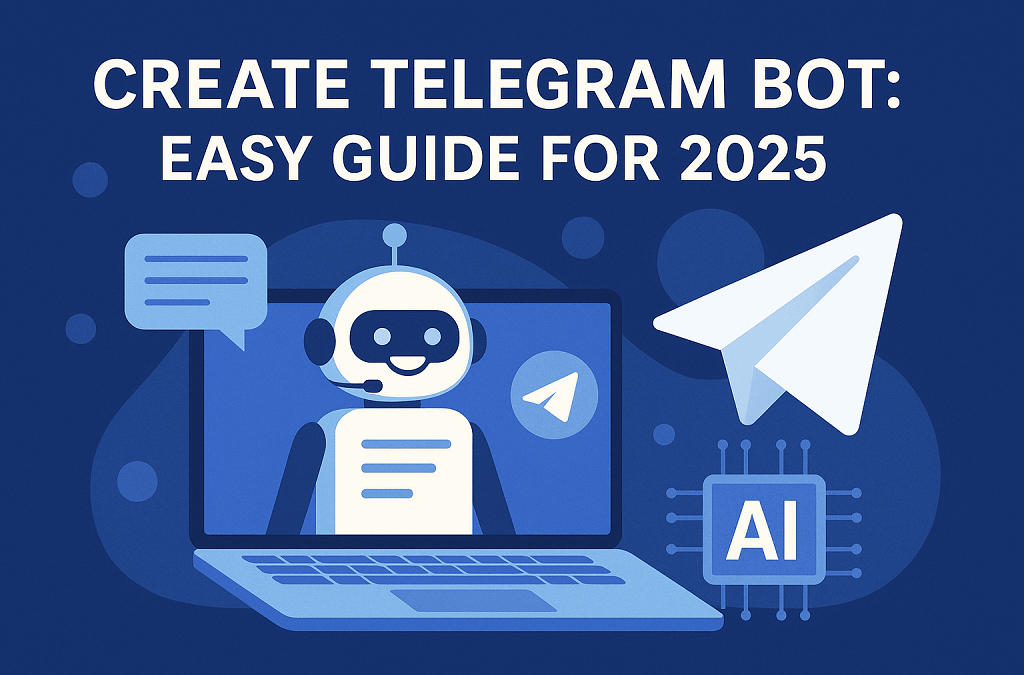
by Polina Yan
Open Telegram in 2025 and it feels less like a messenger and more like a universe. You’ve got channels pumping out news, groups with thousands of members, and bots running behind the scenes doing everything from selling tickets to running customer support. They’re not a gimmick anymore — they’re the backbone of how people interact with brands, creators, and even local communities.
That’s why so many people now want to create Telegram bot of their own. Some do it to automate work, like handling FAQ messages so they don’t answer the same thing a hundred times a day. Others use bots to share exclusive content with subscribers, manage payments, or even build niche communities where the bot acts as host and organizer.
And the demand keeps rising. Telegram has passed 900 million active users worldwide, and millions of them touch a bot every single day without even thinking about it. Bots deliver reminders, process orders, send files, or connect users with AI tools.
That momentum isn’t just something marketers talk about — Telegram’s own numbers show how big the platform has become. Recent coverage of Pavel Durov’s announcement underlines just how massive the audience already is.
“Telegram now has significantly over 1 billion monthly active users, becoming the second most popular messaging app in the world (excluding the China-specific WeChat).”
— Pavel Durov, via NDTV Profit
Put that next to the 900+ million figure you see in many stats and it’s obvious why bots are exploding: even a tiny slice of that user base can sustain a serious product or side business. When you create a Telegram bot in 2025, you’re building on top of one of the largest real-time communication platforms in the world.
This guide walks through the journey — from the simple “hello world” bot to advanced setups powered by AI. By the end, you’ll see exactly how bots work, why they matter, and how you can launch one yourself.
Why Build a Telegram Bot in 2025?

Scroll through Telegram today and you’ll notice something: half the time you’re not talking to people at all. It’s bots sending updates, answering questions, or nudging you to buy something. They’ve gone from novelty to necessity. If you run a business, a community, or even a personal project, learning how to create bot Telegram is like giving yourself an extra pair of hands that never sleep.
The beauty of bots is how wide the use cases run. A restaurant can take lunch orders in chat. A shop can process payments without a website. Creators set up subscriber channels that drip out content every morning. I’ve seen fan groups use bots to manage polls and events, while one adult creator runs an OnlyFans Telegram bot that handles paid updates without lifting a finger.
Here’s what bots do best:
- Push promotions, newsletters, or personal updates straight into a user’s chat.
- Act as the first line of customer support, answering repetitive questions instantly.
- Collect payments, donations, or subscription fees with a few taps.
- Deliver content — from breaking news to private lessons — automatically.
- Moderate and organize communities so humans don’t burn out.
And the kicker? They’re cheap to run compared to human teams. A small shop can avoid hiring extra staff just by letting a bot handle bookings and questions. Big companies save millions on support calls. Communities keep members engaged without burning through volunteer time.
Telegram already has the audience — close to a billion people using it every month. Bots are the glue that keeps them connected to the services, creators, and businesses they care about. If you’ve got an idea, odds are a bot can make it easier to deliver.
The Basics: How to Create a Bot in Telegram

When people look up guides on how to create a bot in Telegram, the answer is almost always the same: start with BotFather. This official account is Telegram’s gatekeeper for new bots, and every project — from a simple helper to a full AI assistant — begins there.
Open BotFather, hit /newbot, and follow the prompts. It feels less like coding and more like filling out a short form:
- Choose a display name.
- Pick a unique username ending with “bot.”
- Receive your API token — a long string of letters and numbers that unlocks access to your bot.
That token is gold. Keep it private, just like you would a password.
First Steps With BotFather
With the token in hand, it’s time to connect code. Beginners usually reach for Python or Node.js, since both have strong libraries ready to go. Using python-Telegram-bot, you can write a few lines, run the script, and watch your new bot reply “Hello, world.” It’s basic, but seeing that first message pop up in Telegram feels like magic.
From there, most people add features step by step. Common upgrades include:
- Quick commands that return weather updates or daily tips.
- A small database to remember user info.
- Predefined responses to FAQs.
Each feature works like stacking blocks. Start with one, test it, then move to the next. The best bots are built gradually, not in a single marathon coding session.
One last thing: guard that token. Don’t paste it into public code or screenshots, and rotate it if you think it’s leaked. It’s the key to your bot, and without it, everything stops.
Creating a Telegram bot is less about memorizing every command and more about understanding the flow: BotFather issues the token, your code listens for messages, and the bot responds. Once you’ve grasped that cycle, you’re already past the hardest part.
Under the hood, that whole flow is powered by the same public interface, no matter which language or framework you choose. Telegram itself describes this layer in very simple terms in its official developer documentation.
“The Bot API is an HTTP-based interface created for developers keen on building bots for Telegram.”
— Telegram Bot API documentation
Every time your code sends or receives a message, it’s talking to this API — python-telegram-bot, Telethon, or aiogram are just friendly wrappers around it. Once you understand that, scaling from a “hello world” bot to production-ready automation feels much less mysterious.
From Simple Scripts to AI-Powered Bots

Every Telegram bot starts out plain. You write a script that spits back an answer when someone types a keyword. Ask it “/hello” and it replies “Hi there.” Useful? Barely. But it’s the first brick.
The fun begins when you connect that little script to something real. Hook it to a weather API and suddenly the bot gives tomorrow’s forecast. Point it at a news feed and you’ve got headlines on demand. Tie it to a crypto exchange and your group gets live price alerts without opening a browser.
That’s when you stop seeing bots as toys and start seeing them as tools.
Specialist app developers looking at Telegram from the outside see the same thing: bots are no longer side projects, they’re core infrastructure. One mobile studio that breaks down Telegram-style apps for clients sums it up like this.
“Telegram’s bot platform allows developers to create automated accounts to perform various tasks.”
— Nimble AppGenie
That’s exactly what you’re tapping into when you connect your bot to payments, AI, or external APIs. You’re not just adding a gimmick — you’re wiring automation directly into the same chat interface your users already open dozens of times a day.
And then comes the bigger step: adding brains. An AI bot Telegram project doesn’t just follow a script — it talks back like a person. Link it to a GPT-style model or your own ML engine and the conversations change. Users can ask open questions, and the bot doesn’t fall apart after the second reply. That’s what people mean when they talk about Telegram AI chatbot — it’s the difference between an answering machine and an assistant.
Scaling Into Advanced Features
Once you’ve got a smart bot running, the list of upgrades is endless. A few of the ones developers actually use in 2025:
- Multi-language chat so one bot serves global audiences.
- Voice recognition that lets people speak instead of type, with instant speech-to-text.
- Built-in payments for subscriptions, donations, or selling digital goods right inside Telegram.
Stack these features together and the bot stops being an experiment. It becomes part of a business. Shops use them to sell directly in chat. Teachers run tutoring sessions. Creators run entire subscription models.
It’s a slow build — script, then integrations, then AI. But that’s the path from “hello world” to a bot people actually rely on every day.
Best Tools and Frameworks for 2025

Once you’ve got the basics down, the next question is: what’s the best way to actually build? Developers in 2025 have a toolbox full of choices, from hardcore coding libraries to drag-and-drop bot builders. The right pick depends on how deep you want to go.
On the coding side, three names stand out. python-telegram-bot is the most beginner-friendly, with clear docs and a big community. Telethon digs deeper, giving you full access to Telegram’s API and letting you do advanced stuff like managing channels and accounts. aiogram sits in between — asynchronous, flexible, and perfect if you’re aiming for speed and scalability.
Not everyone wants to touch code, though. That’s where no-code and low-code platforms come in. FlowXO offers pre-built blocks, so you can drag together a working bot without typing more than a few lines. Manybot lets creators spin up bots directly inside Telegram with simple commands. Tars is aimed at businesses, helping them design conversational flows for customer support or sales.
Each tool has its trade-offs. Libraries give you maximum control but require coding chops. No-code platforms get you running fast, but you’ll hit limits if you want advanced AI features or complex integrations.
Here’s a quick look at the landscape:
| Tool / Framework | Code/No-Code | AI Support | Pricing | Best For |
| python-Telegram-bot | Code | Yes | Free | Beginners, simple bots |
| Telethon | Code | Yes | Free | Advanced devs, full API access |
| aiogram | Code | Yes | Free | Scalable, async projects |
| FlowXO | No-Code | Limited | Freemium + Paid | Quick prototypes, small teams |
| Manybot | No-Code | Limited | Free | Creators, hobby projects |
| Tars | Low-Code | Yes | Subscription | Businesses, customer support |
Real-World Examples of Telegram AI Bots
It’s one thing to talk about bots in theory, but the real proof is seeing them in action. Across industries, Telegram AI bots are now taking on jobs that used to eat up time, money, and human energy.
- E-commerce support: Consider an online shop with hundreds of daily queries on sizes, shipping, or returns. Instead of a small team handling all, a Telegram AI bot responds instantly. It solves mundane issues, guides clients through orders, and hands over only the problematic cases to human agents. The result: faster resolution and lower costs.
- Healthcare assistants: Clinics and hospitals are using an AI Telegram bot to let patients book appointments, check clinic hours, or get answers to simple medical FAQs. It doesn’t replace doctors, but it removes a mountain of admin work, cutting wait times for everyone.
- Education helpers: Schools and private tutors run Telegram AI bots that deliver quizzes, reminders, or practice tests. Some even translate lessons into multiple languages, helping teachers reach students across borders without extra prep time.
- Adult content delivery: Creators are leaning on automation too. An OnlyFans Telegram bot manages subscriptions, sends exclusive updates, and keeps track of renewals. It means less manual admin and more focus on creating content that actually sells.
The lesson here is simple: when you create Telegram bot powered by AI, you stop treating it as a novelty. It becomes part of the daily workflow, handling the repetitive jobs that burn people out. From shops to clinics, schools to creators, the applications are growing — and the bots are already proving their value.
Building a Custom Bot With Scrile
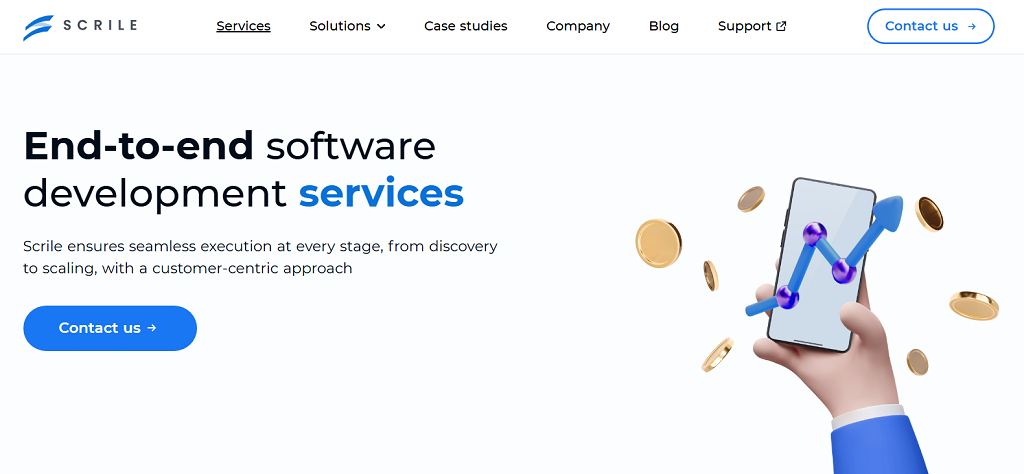
By now, you’ve seen the power of bots — from simple helpers to full AI-driven assistants. But there’s a catch. Most off-the-shelf builders lock you into their design, their limits, and their revenue cut. If you want real freedom, the answer isn’t another template app. It’s to create Telegram bot with a team that builds it around your idea from the ground up. That’s what Scrile does.
Scrile isn’t a pre-packaged bot service. It’s a full software development team that creates custom solutions — tailored for businesses, communities, or creators who want control over how their bot looks, works, and earns. Instead of squeezing your idea into someone else’s box, you get the box built for you.
Some of the key features include:
- 0% commission monetization: keep everything you earn, from subscriptions to in-chat sales.
- White-label design: your name, your colors, your identity. Users see your brand, not a third party’s.
- Secure payments: integrated checkout flows with trusted gateways to protect both you and your customers.
- AI integration: connect to advanced models so your bot goes beyond scripted replies and actually converses.
Why Choose Scrile Service
Because every idea is different. A retail brand might need e-commerce integrations. A clinic may want patient booking and privacy compliance. A creator could be looking for a bot that delivers paid content automatically. Scrile takes those requirements and turns them into reality.
You’re not just getting code. You’re getting a system that scales, adapts, and grows with your business. Professional support is part of the package, so you’re never left wondering how to fix a broken feature or roll out an update.
Conclusion
Learning to create Telegram bot in 2025 is easier than ever. You can start with BotFather and a few lines of code, add integrations for news or payments, and grow into advanced AI features that handle real conversations. Bots aren’t side projects anymore — they’re powering online shops, healthcare systems, classrooms, and even creators’ subscription models.
If you’ve got an idea that deserves more than a template solution, don’t wait. Contact Scrile team today to launch a custom Telegram bot built around your brand, your community, and your goals.
FAQ
How long does it take to create Telegram bot?
It will also depend on what exactly you want your bot for. A basic model that simply follows commands can be up and running within a few hours with the help of BotFather and a minimalist script. Bots with AI capabilities, online wallets, or custom design take longer — at least several weeks of active development and debugging.
Are AI Telegram bots expensive to run?
Not necessarily. The costs mainly come from hosting and any AI model you connect. A small AI Telegram bot that handles simple conversations can run cheaply on cloud servers. If you’re adding complex machine learning features or processing heavy data, you’ll need stronger infrastructure, which raises costs. Still, most businesses find it cheaper than hiring full support teams.
Can I monetize my Telegram bot?
Yes. Many creators and companies already do this. You can sell subscriptions, run paid content channels, process one-time purchases, or accept donations directly inside Telegram. If you plan to create Telegram bot as a business tool, Scrile software development services can even help you set up secure payments and custom monetization models with 0% commission.
Polina Yan is a Technical Writer and Product Marketing Manager, specializing in helping creators launch personalized content monetization platforms. With over five years of experience writing and promoting content, Polina covers topics such as content monetization, social media strategies, digital marketing, and online business in adult industry. Her work empowers online entrepreneurs and creators to navigate the digital world with confidence and achieve their goals.

by Polina Yan
A consultant without a strong online presence in 2025 might as well be invisible. Potential clients don’t flip through directories anymore—they type a name or a service into a search bar, click, and make judgments in seconds. The best consulting websites are built with this reality in mind. They don’t only inform, they convince.
What counts as consulting today is broader than ever. Finance advisors and IT specialists share space with nutrition coaches, HR mentors, branding experts, and even adult industry consultants who guide creators and entrepreneurs on strategy, compliance, and monetization. All of them need a site that reflects credibility, clarity, and personality.
A great consulting website doesn’t shout; it guides. It makes it easy to understand who you are, what you offer, and how to take the next step—whether that’s booking a session, joining a newsletter, or exploring case studies. The design, the copy, and the tools behind the scenes all shape the impression a visitor takes away.
In this article we’ll explore standout consulting sites, break down the design choices that make them effective, and show how you can apply those same principles to your own project.
Why Website Design Matters for Consultants

Think about the last time you searched for a professional online. You probably clicked, looked around for a few seconds, and made up your mind fast. That’s exactly how people judge consultants. A site that feels clumsy or vague sends them away. A site that feels clear and trustworthy? That’s when they stay.
For many solo consultants, the website isn’t just decoration—it’s the business itself. A wellness coach might sell sessions directly through it. An HR consultant could use it as a calendar for bookings. Someone in the adult industry might rely on it to show they’re professional, safe, and easy to reach. In all these cases, the website is part storefront, part résumé, part handshake.
The best websites for consultants all have one thing in common: they lower the barrier between curiosity and action. That doesn’t mean flashy graphics or endless text. It means a design that answers the unspoken questions a visitor always has: “Can I trust this person? Do they know their stuff? How do I talk to them?”
For consulting, coaching, and expert services, this isn’t just about “looking good.” In trust-heavy fields, your website is the first serious proof that you’re worth listening to. As one digital agency working with professional services firms puts it in a recent insight on online credibility from Itineris:
“Reputation is built on credibility, and today, credibility begins online.”
— Harry Hammett, Itineris
That’s exactly what the best consulting websites do: they turn a few seconds of browsing into a clear signal that you’re competent, serious, and ready to solve real problems.
Key Client Expectations in Consulting Websites
Here’s what clients actually notice when they land on a page:
- The site loads quickly, and it looks good on a phone.
- There’s a small lock icon in the browser—proof the connection is secure.
- Real names, faces, or testimonials show up instead of vague promises.
- There’s a button that makes it obvious how to book, call, or send a message.
None of this is glamorous, but it works. When those basics are missing, visitors feel uneasy. When they’re in place, the site fades into the background and lets the consultant’s expertise take the spotlight.
Characteristics of the Best Consulting Websites

When you start browsing consulting sites, patterns emerge. The ones that leave a strong impression usually feel personal without losing professionalism. A clean logo, a color palette that doesn’t fight with the content, and photos that actually look like the real person behind the business—these small touches make it easier to trust what’s being offered. Visitors want to see a face and a story, not just stock images and vague promises.
Another defining trait is clarity right at the top of the page. The strongest sites don’t bury their pitch halfway down. Instead, they put their value proposition “above the fold,” where anyone arriving can immediately understand the service. Think of a single line that answers: Who are you, and why should someone listen? That opening moment sets the stage for everything else.
Good design isn’t just about looking sharp—it’s about helping visitors act. Booking calendars that sync with popular tools, quick chat options, and secure payment buttons all add momentum. When a potential client feels the site guiding them step by step, the barrier between interest and commitment gets thinner.
Design choices aren’t just aesthetics; they quietly decide whether visitors see you as credible or forgettable. Recent research summarized by Midas Touch Infotech shows just how much people lean on design when judging a business.
“68% of users are judging your business based on your web design.”
— Midas Touch Infotech
When you pair that statistic with clear copy and strong calls to action, it becomes obvious why polished consulting websites outperform generic templates: they look trustworthy and make the next step effortless.
Features That Convert Visitors into Clients
Look through real consulting website examples and you’ll notice a consistent toolkit:
- Interactive elements: calculators to estimate costs, short quizzes to define a problem, or downloadable guides that prove expertise before money changes hands.
- Evidence of results: clear portfolios, project snapshots, or client success stories that don’t read like fluff but show measurable impact.
- Calls to action in the right places: instead of dumping one big “Contact me” button at the bottom, smart sites sprinkle actions where they make sense—after a case study, beside a testimonial, or within a pricing section.
- Transparency in services and pricing: not always a detailed list of numbers, but at least enough to let visitors gauge if they’re in the right ballpark.
- Accessibility across devices: not a flashy feature, but critical. If the site lags on a phone, clients won’t wait.
Together, these elements form a rhythm: credibility first, action second. The websites that master this rhythm are the ones people remember—and more importantly, the ones people contact.
That “evidence of results” is what turns a nice-looking site into a convincing one. Agencies that specialize in consulting websites consistently point to social proof—testimonials, case studies, client logos—as the strongest trust lever you can pull. As Knapsack Creative notes in their guide on consulting website social proof:
“The most powerful way to build that trust online is through social proof.”
— Knapsack Creative
This matches what you see in the best consulting websites you analyze: they don’t just say they get results—they show real clients, real outcomes, and let that proof do the heavy lifting.
Best Consulting Website Examples in 2025
Learning design principles on paper is helpful, but watching them in action in actual sites makes the lessons more memorable. The best consulting websites have in common just a few characteristics—a clear brand, compelling text, and features that push people forward toward action. Large companies employ such strategies in order to leverage their influence, and small players use them in order to hold ground against crowded spaces. Following are six sites that demonstrate how this is done, each with a distinctive style but with an alarmingly similar foundation.
McKinsey & Company
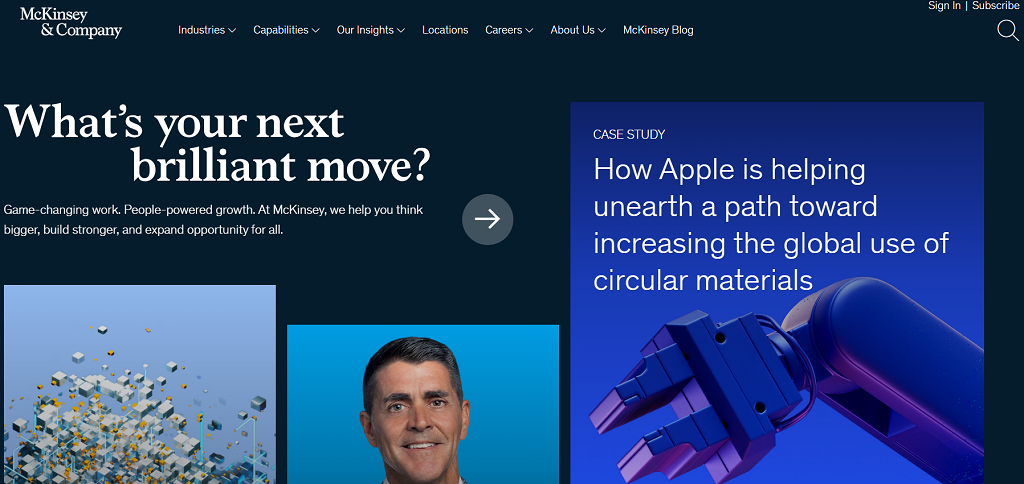
McKinsey’s website is a masterclass in authority-building. It isn’t flashy; instead, it feels like an encyclopedia of insights, filled with research reports, interactive graphics, and trend analysis. The homepage greets you with bold statements supported by numbers, while the navigation leads to deep dives on industries, case studies, and global issues.
Key Features:
- Data-driven articles and reports published regularly.
- Clear industry segmentation, making it easy for visitors to find their sector.
- Minimalist design that highlights content over decoration.
- Consistent calls to action encouraging readers to explore or subscribe.
Takeaway:
By focusing on knowledge-sharing, McKinsey builds trust long before a potential client even considers reaching out. Visitors come for insights and leave with the sense that this firm has the resources to solve large-scale problems.
Boston Consulting Group (BCG)
BCG’s site leans into visual storytelling. The homepage immediately feels dynamic, with bold typography and interactive features that highlight their focus on transformation and innovation. Scrolling through, you’ll encounter case studies packaged almost like short documentaries, balancing sharp design with digestible information.
Key Features:
- Strong visual identity reinforced through photography and motion design.
- Case studies presented with interactive graphics.
- Content grouped by themes such as sustainability, digital, or leadership.
- Prominent links to global insights and reports.
Takeaway:
BCG proves that a corporate consulting site doesn’t have to be dry. Their design choices make complex business transformation stories accessible and engaging, showing how visual presentation can turn information into inspiration.
GrowthLab by Ramit Sethi

GrowthLab isn’t a corporate giant—it’s built around Ramit Sethi’s personal brand, and that’s exactly what makes it powerful. The site feels like a conversation rather than a lecture. Bold headlines, direct copy, and clear funnels guide visitors into signing up for courses or newsletters. Every element reflects the idea that trust is earned by being upfront and personable.
Key Features:
- Prominent personal branding with photos and direct messaging.
- Lead magnets like free guides and email courses.
- Simple layouts that push attention toward calls to action.
- Stories and testimonials that emphasize transformation.
Takeaway:
GrowthLab shows how personality and expertise can carry a consulting business online. Independent consultants can study this approach and see how personal branding paired with lead capture tools creates a steady pipeline of clients.
Lisa Richey, Business Etiquette Consultant

Lisa Richey’s site is an excellent demonstration of how niche consultants can shine. The site is friendly, clear, and rooted in her specialization—etiquette instruction. The homepage introduces the visitor at once as an accessible expert, and the navigation centers on in-use services such as workshops and training programs.
Key Features:
- Clear description of services with easy booking options.
- Testimonials from clients to reinforce credibility.
- Personal photos that highlight trustworthiness and relatability.
- A simple but polished design that keeps focus on the message.
Takeaway:
Her site proves that the best independent consultant websites aren’t necessarily in need of vast contents databases. A solid niche specialization, supplemented with trust indicators and friendly design, is enough to give one consultant the same sense of credibility as that of a bigger company.
Erika Heald Consulting
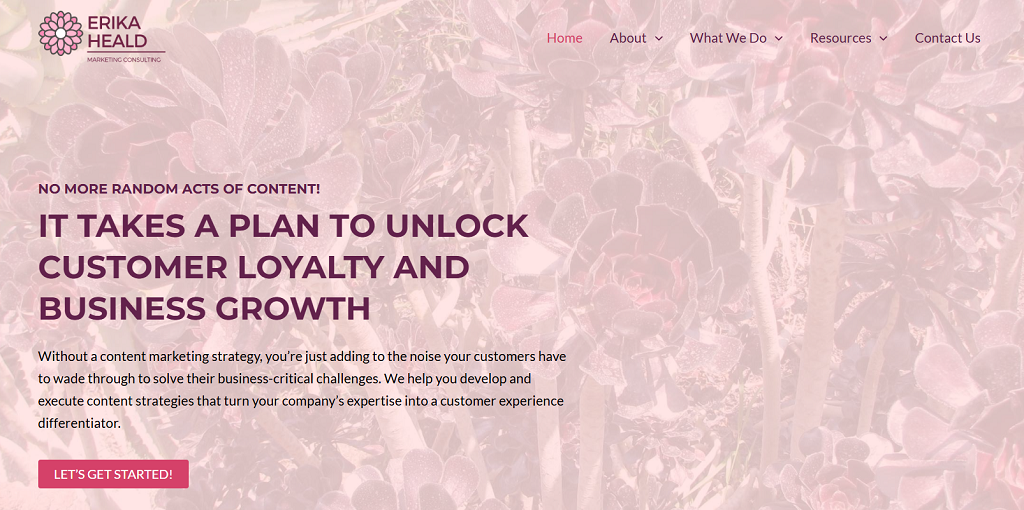
Erika Heald’s site is built around clarity. Instead of overwhelming visitors with jargon, the copy focuses on what she actually does—content strategy, community building, and consulting for businesses that want a sharper voice online. The layout is straightforward, but the simplicity works in her favor.
Key Features:
- Direct messaging that avoids buzzwords.
- Easy navigation that highlights core services.
- Blog posts and resources that display expertise.
- Clear contact paths that invite quick outreach.
Takeaway:
Erika’s website proves that consultants don’t need complexity to stand out. By putting services front and center, and avoiding distractions, she creates a frictionless experience that inspires confidence in potential clients.
Bain & Company
Bain’s website is polished in a different way from McKinsey or BCG. It feels less like an academic resource and more like a guided journey. Each section is designed to lead you somewhere—whether that’s a case study, an industry insight, or a service explanation. The storytelling approach draws you deeper with every scroll.
Key Features:
- Engaging homepage with client-centric stories.
- Intuitive navigation through industries and solutions.
- Consistent use of photography and design elements to add warmth.
- Calls to action woven naturally into each section.
Takeaway:
Bain shows how large firms can balance authority with accessibility. Instead of relying only on research-heavy content, they mix storytelling with clear service offerings, making the visitor feel like they’re part of the narrative.
Comparison of Key Elements Across Top Consulting Websites
| Website | Type | Standout Feature | Takeaway |
| McKinsey | Global firm | Research insights hub | Authority built through deep, data-driven content |
| BCG | Global firm | Interactive case studies | Visual storytelling makes complex topics engaging |
| GrowthLab | Independent | Lead magnets, courses | Personal brand paired with funnels drives sales |
| Lisa Richey | Niche | Service clarity, testimonials | Focus and approachability build strong trust |
| Erika Heald | Independent | Simple, direct messaging | Clarity and frictionless navigation win confidence |
| Bain & Company | Global firm | Client-centric stories | Guided storytelling turns visitors into prospects |
How to Build a Consulting Website That Stands Out

There’s no shortage of ways to get a site online. A solo consultant might be tempted by DIY website builders: quick, cheap, and with plenty of templates. The problem? Those templates often look the same, and when every competitor uses the same design, you fade into the background. SaaS-based solutions offer more polish but still come with limitations—branding that isn’t truly yours, features you don’t control, and subscription fees that pile up. Larger firms usually move toward custom-built solutions because they need security, scalability, and full ownership. That’s the difference between a site that blends in and one that competes with the best consulting websites.
If you want to build a consulting website that carries weight, start by planning beyond aesthetics. Design matters, but so does the flow: how someone books you, how payments are handled, and how you prove you’re worth hiring.
Practical Steps to Start Today
- Define your niche and audience – Know exactly who you want to reach and tailor your message for them.
- Choose your monetization model – Will you charge hourly, offer packaged services, or build a subscription plan?
- Prioritize branding and payments – Your logo, color scheme, and story should be consistent, while payment options need to be seamless and secure.
- Add engagement tools – Booking calendars, live chat, or gated content help turn casual visitors into paying clients.
Developing online presence is more than that initial setup—it’s iterative. The finest consulting sites grow along with the consultant, tightening up as services expand or audiences shift. What distinguishes the finest aren’t templates—it’s the judicious combination of personal branding, trust markers, and working tools that streamline business both ends.
Scrile Meet: Customizable Development for Consulting Websites
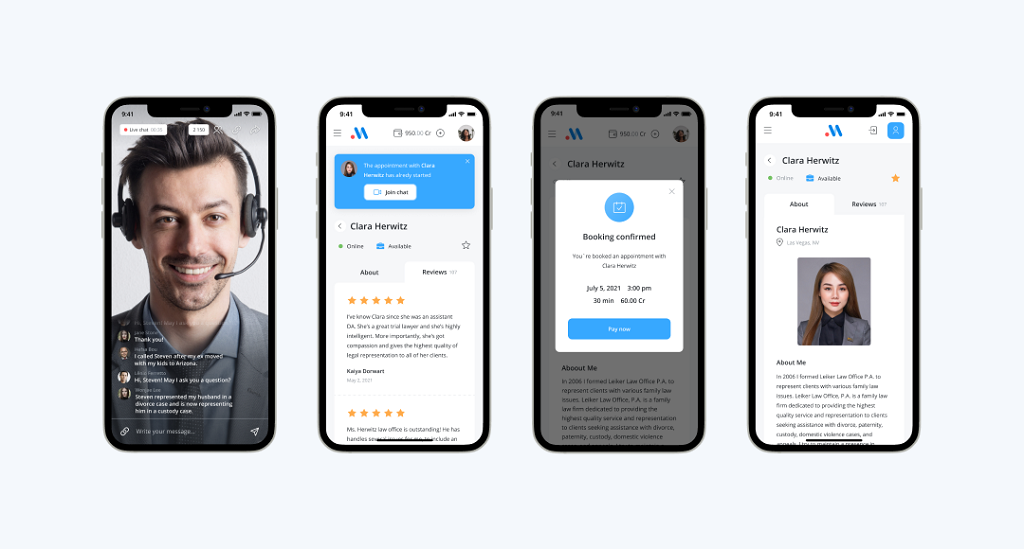
Most consultants outgrow generic templates quickly. You might start with a drag-and-drop builder, but as soon as you need secure payments, branded video sessions, or scalable tech, the cracks show. Scrile Meet fills that gap. It’s not a pre-made platform—it’s a development service that adapts to your goals, giving you the flexibility to create a consulting site that holds its own among the best consulting websites.
With years of experience across varied industries—from corporate advisory firms to adult coaching—Scrile Meet understands how consultants shape and grow their online presence. The service combines this experience with a toolkit built to support consultants who want more than surface-level design.
Key benefits include:
- Full white-label branding that puts your name, not someone else’s, front and center.
- Live video consultation features, covering both one-on-one and group sessions.
- Integrated payment systems with direct payouts for smooth transactions.
- Flexible monetization models, from subscriptions and pay-per-minute billing to premium content.
- Scalable, low-latency technology (WebRTC/RTMP) that ensures calls and streams feel seamless.
Behind these features sits a support system—project managers, custom developers, and 24/7 hosting—that ensures the site isn’t just launched but actively maintained. For consultants, that means the freedom to shape a site around your practice rather than squeezing your practice into a rigid template.
Scrile Meet positions itself as a long-term partner, making sure your consulting website can evolve alongside your business.
Conclusion
The best consulting websites all follow the same thread: they make services clear, build trust with proof, and rely on technology that makes the client’s next step effortless. From global names like McKinsey to niche professionals running solo practices, the examples show that size doesn’t matter—clarity and function do. If you’re ready to take your consulting business online or improve what you already have, the next step is simple. Define your goals, think about how you want to engage clients, and contact the Scrile Meet team today to discuss a site built exactly around your needs.
Polina Yan is a Technical Writer and Product Marketing Manager, specializing in helping creators launch personalized content monetization platforms. With over five years of experience writing and promoting content, Polina covers topics such as content monetization, social media strategies, digital marketing, and online business in adult industry. Her work empowers online entrepreneurs and creators to navigate the digital world with confidence and achieve their goals.

by Polina Yan
The webcam chat industry has come a long way from simple one-way video streams. In 2025, platforms are expected to do more than just connect users—they need to engage, monetize, and scale. Live video alone isn’t enough. Audiences now expect private chat options, tipping systems, interactive overlays, and flawless streaming across all devices.
The webcam business is no longer a tiny niche — it’s a full-scale industry with serious money and serious competition. Studios and solo creators now fight for attention on a global level.
“Take adult web-camming, for example, a billion-dollar global industry in which content creators build up devoted followings as they stream themselves to meet endless demand.”
— Lily Hay Newman, WIRED
That level of demand is exactly why your tech stack can’t be an afterthought. If your script can’t keep streams stable and interactive, viewers will simply move to the next site.
That’s where script chat cam solutions come into play. Instead of building everything from scratch, entrepreneurs and studios can launch fully functional platforms using pre-built or custom scripts that handle video, chat, payments, moderation, and more. These tools offer the control and flexibility needed to shape a brand, while also giving creators and performers the tools to earn and interact in real time.
This article explores the top five script chat cam solutions available in 2025. Whether you’re launching a new cam site or upgrading your existing setup, these tools can help you deliver a polished, profitable experience without compromising on features or performance.
What Makes a Great Script Chat Webcam Tool?
A solid script chat webcam solution is more than just a video player and a chatbox. At its core, it combines real-time video streaming with interactive chat, integrated billing, performer dashboards, admin controls, and user management—all built to support high-volume traffic and monetization.
But not all scripts are created equal. Stability and stream quality should come first. If a broadcast lags or drops, users leave. The interface matters too: performers need intuitive tools to manage shows, while viewers want smooth navigation and fast interaction.
Built-in payment options—like credit card billing, tokens, or crypto—are essential. Add moderation tools to prevent abuse, and you’ve got a platform that’s safer for everyone. Finally, look for scripts that support various revenue streams: pay-per-minute shows, tips, locked content, and private sessions.
Choosing the right solution from the beginning helps avoid major technical headaches later and lays the foundation for scaling your platform with confidence.
Tipping, tokens and paid gifts aren’t just “nice extras” anymore — they’re how viewers actively participate in shows and how performers turn attention into income. For modern cam platforms, that engagement layer is part of the core product, not a bonus feature.
“Livestream gifting is no longer a niche feature; it is a mainstream cultural and economic force, redefining entertainment and building deeper audience connection.”
— TikTok & Ipsos, “The Creator Economy Redefined: How Interactive Livestream Gifting is Transforming Entertainment”
When you evaluate script chat cam solutions, look closely at how they handle tips, gifts and tokens. The better they support this “participation economy,” the easier it is for your performers and studio to grow revenue.
Top 5 Script Chat Cam Solutions in 2025
If you’re building a cam platform this year, choosing the right script chat cam tool can make or break your launch. Here’s a rundown of five standout solutions—each offering something different for startups, studios, and growing platforms.
| Solution | Best For | Key Features | Limitations | Ease of Launch |
|---|
| Video Chat Script (Soft112) | Small teams / solo startups | Pay-per-minute, performer/admin dashboards, multi-cam | Very limited customization, not scalable | ✅ Quick / cheap |
| Online-Webcam.net | Fast deployment | Templates, performer accounts, payment gateways, revenue tracking | Dated front-end design | ✅ Plug-and-play |
| PaidVideoChat (VideoWhisper) | Flexible pay models | Private shows, multi-host, WordPress integration, tipping | Technical setup required | ⚡ Moderate |
| xCams (Adent.io) | Professional platforms | HD streaming, token billing, dashboards, moderation | Developer needed, higher cost | 🔧 Custom dev |
| Scrile Stream | Long-term growth, branded sites | Custom development, tipping, tokens, affiliate support, full ownership | Not “ready out-of-the-box” | 🏗️ Tailored build |
Video Chat Script (Soft112)
This script is best known for its simplicity and straightforward pay-per-minute functionality. It includes a performer interface, admin dashboard, and multi-cam support for models, making it a decent pick for small teams or solo entrepreneurs starting out. It does the bare minimum like video chat and session billing, but otherwise, choices are limited. There isn’t a lot of customization, so expanding larger may mean expanding out of it. But it’s a fast and inexpensive way to get your foot in the cam door without a lot of initial investment.
Online-Webcam.net

Designed for fast deployment, this option gives users an entire plug-and-play site—complete with templates, performer accounts, and payment gateway support. It’s surprisingly flexible for a ready-made package. Performer dashboards are customizable, and it includes tools for show scheduling and revenue tracking. The only drawback is its slightly dated front-end design. It’s a practical pick for those who want to launch quickly and tweak things as they go, without building a platform from scratch.
PaidVideoChat by VideoWhisper
PaidVideoChat by VideoWhisper is a live video chat script tailored for pay-per-minute models, tipping, and interactive webcam chat. It’s ideal for platforms that want flexibility around pricing and session formats. The script supports private shows, multi-host interactions, mobile streaming, and can integrate with WordPress. It’s more technical to configure than some turnkey platforms, but makes up for it with performance and monetization depth.
xCams by Adent.io

xCams by Adent.io is a white-label live cam site script with a focus on professional-grade performance and customization. It includes high-definition streaming, user and performer dashboards, token-based billing, and advanced moderation features. It is built for businesses that want to launch serious platforms with room to scale. It’s not a plug-and-play tool—you’ll want a developer or their team’s assistance—but in return, you get full control over how your cam site functions and grows.
Scrile Stream
Not a script in the traditional sense—Scrile Stream is a custom development solution. It offers flexibility far beyond plug-and-play tools, making it ideal for those wanting a branded platform with long-term growth in mind. More on that in the next section.
Scrile Stream: The Best Development Solution for Your Webcam Business
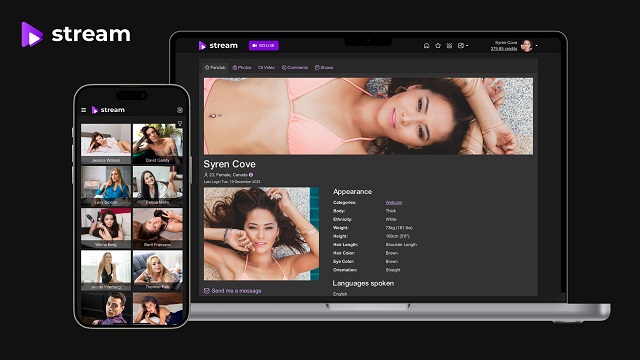
Unlike plug-and-play scripts, Scrile Stream offers a custom-built cam site solution tailored to your business model. It’s not just another template—it’s a full development service designed to launch powerful, branded platforms with real-time streaming, interactive chat, tipping systems, paid messages, and virtual tokens.
Scrile Stream also comes equipped with essential tools like affiliate program support, payment gateway integration, and moderation features that help keep your platform safe and monetized. It’s ideal for entrepreneurs who need more than a basic out-of-the-box system.
What sets it apart? Total control. No vendor lock-in, no design limitations, and full ownership of your platform’s code and user experience. If you’re looking for a serious script chat cam alternative with room to scale, Scrile Stream delivers.
That’s the real dividing line between a quick script and a long-term platform: do you truly own the environment your business runs on, or are you renting space under someone else’s rules? Free and semi-free platforms always come with hidden trade-offs.
“Platforms like YouTube or Facebook Live offer free video hosting. But you pay in other ways through limited control, platform ads and lack of ownership.”
— “Video Streaming Hosting in 2025: Best Platforms, Tips & Cost Breakdown”, Bluehost
Scrile Stream follows the opposite logic: you invest in a solution where streaming quality, branding, monetization and data stay under your control, instead of being trapped inside another company’s ad-driven ecosystem
Plug-and-Play Scripts vs. Scrile Stream
| Option | Ownership & Branding | Scalability | Monetization Depth | Support |
|---|
| Typical scripts (Soft112, VideoWhisper, etc.) | Limited, template-based | Harder to expand beyond basics | PPM, tips, private shows | Varies / limited |
| Scrile Stream | Full code ownership, branded UI/UX | Built for growth (enterprise-ready) | PPM, tips, tokens, paid messages, affiliate programs | End-to-end dev & support |
Conclusion: Launch Smarter with the Right Script Chat Cam Solution
A good script chat cam setup is the key to any successful webcam site. Whether you’re going small or going big, the right technology will make you a sensation. Explore Scrile Stream to build a fully branded, revenue-capable webcam chat site built to succeed in 2025 and beyond.
Polina Yan is a Technical Writer and Product Marketing Manager, specializing in helping creators launch personalized content monetization platforms. With over five years of experience writing and promoting content, Polina covers topics such as content monetization, social media strategies, digital marketing, and online business in adult industry. Her work empowers online entrepreneurs and creators to navigate the digital world with confidence and achieve their goals.

by Polina Yan
Back in the early days of remote work, hosting a virtual event meant firing up Zoom, sending out a calendar invite, and hoping everyone showed up. But by 2025, that’s ancient history. Virtual events have become a core part of how we work, teach, promote, and connect. From small workshops with niche audiences to international symposiums featuring hundreds of speakers, the demand for professional, reliable, and feature-rich solutions has exploded.
We’re not just talking about video streams anymore. Modern virtual conference platforms offer a full ecosystem: interactive stages, live chat, networking lounges, sponsor booths, analytics dashboards, and even AI-powered recommendations. Hosting a standout online event now means delivering real engagement and value—not just replicating a meeting in digital form.
Virtual conferences aren’t just a temporary trend from the lockdown era anymore. PR and communications teams now treat online events as one of their main ways to reach audiences. As Reena Aggarwal notes in Agility PR Solutions:
Virtual events deliver faster reach, greater flexibility, and deeper impact—all this with lower costs and in minimal time.
When you’re choosing a virtual conference platform, you’re effectively choosing the infrastructure for that reach, flexibility, and impact. That’s why this comparison focuses so much on reliability, engagement tools, and how well each solution scales with your plans.
Here’s the challenge: the number of tools available has grown just as fast as the events themselves. Some are sleek and easy to use but lack customization. Others offer deep features but require technical skills or large budgets. That’s why this virtual conference platform comparison exists—to help you figure out which platforms are worth your time (and your budget), depending on the type of event you’re planning.
In this guide, we’ll walk through the 10 best virtual conference platform comparison in 2025, highlight their unique strengths, and help you narrow down what works best for your audience, goals, and team size. Whether you’re hosting a virtual summit, an educational forum, or a full-blown branded expo, the right platform can transform your event from functional to unforgettable.
What Makes a Platform Best for Hosting a Conference?

Let’s be honest: you’re not just looking for a place to throw up a Zoom link and pray for engagement. In 2025, expectations for online events are high—and attendees can spot a lazy setup from a mile away. So, what separates decent conference hosting platforms from the ones that actually make people stick around, interact, and remember your event?
First and foremost: reliability. If your keynote speaker freezes mid-sentence or the stream dies during the Q&A, it’s game over. The best platforms for virtual conferences are built to handle high traffic, international time zones, and real-time interactions—without buckling under pressure.
Then there’s flexibility. You might be planning a tight, single-track symposium with a few dozen attendees—or a sprawling virtual expo with breakout rooms, sponsor booths, and overlapping sessions. The top platforms let you scale up or down, add modules, and switch formats without rebuilding the whole thing from scratch.
Let’s talk engagement. Chat boxes are great, but they’re just the start. You want tools that mimic the spontaneous hallway conversation: live polls, virtual networking tables, direct messaging, even speed-meeting functions. If people don’t interact, they don’t stay.
Don’t forget branding. Slapping your logo on a landing page doesn’t count. You want to build an experience that reflects your identity—from the lobby design to button colors. A good platform should make your event feel like yours, not a template.
And finally: analytics. It’s not just about who showed up—it’s about how they moved through your event. What they clicked, how long they watched, where they dropped off. Smart tracking helps you understand what worked and what didn’t—and do better next time.
In short: virtual conferences platforms need more than just video. They need structure, personality, and room to grow.
Quick Comparison of the 10 Best Virtual Conference Platforms (2025)
| Platform | Best For | Key Strengths | Limitations | Pricing (est.) |
|---|
| Zoom Events | Large-scale, hybrid events | Reliability, enterprise trust, multi-track support | Limited customization, corporate feel | From $1,500/yr |
| Hopin (RingCentral Events) | Sponsor-heavy, interactive summits | Networking, expo zones, Q&A, booths | Complex dashboard, steep pricing | $800–$1,000/event |
| SpotMe | Corporate & medical conferences | Compliance, multilingual, mobile apps | Best for enterprise, less for casual events | Custom pricing |
| Webex Events (Socio) | Enterprises, global teams | Branding, scalability, gamification | Costly, enterprise-focused | Custom pricing |
| Airmeet | Community-driven workshops | Virtual tables, networking, ease of use | Less formal, fewer sponsor features | From $200/mo |
| BigMarker | Marketers & B2B lead gen | CRM/email integration, automation | Less “flashy,” more functional | $99–$500/mo |
| vFairs | Virtual expos & trade shows | 3D lobbies, booths, sponsor showcase | Steep setup, long learning curve | Custom pricing |
| HeySummit | Small, niche events | Easy to launch, simple ticketing | Not scalable for large expos | From $29/mo |
| ON24 | Enterprise marketing & demand gen | Deep analytics, CRM integrations | Expensive, steep learning | From $500/mo |
| Run The World | Casual, interactive gatherings | Mobile-first, fun, speed networking | Light on customization | From $99/mo |
1. Zoom Events

Zoom’s event platform is built for scale. It takes what people already trust from regular Zoom and expands it into a system for large, organized virtual gatherings. It’s designed to handle everything from webinars and town halls to full-scale conferences.
With support for tens of thousands of attendees, Zoom Events offers multi-track agendas, ticketing, sponsor integration, and backstage access for presenters. It’s a strong option among conference hosting platforms, especially for enterprises that already use Zoom in-house.
Where it really works is hybrid events. If you’re combining a physical venue with a remote audience, this platform offers a reliable bridge between the two.
That positioning isn’t just marketing copy. In its hybrid events research, Zoom highlights how much event teams now rely on hybrid formats to extend reach and prove ROI:
Hybrid events offer event marketers a variety of benefits that include expanding their reach to a larger audience, lower costs, and greater access to data
For organizers, that reinforces why hybrid-ready infrastructure in Zoom Events matters so much: registration flows, backstage tools, analytics, and networking all feed into a single event story. If your roadmap includes more complex hybrid conferences, that data layer becomes just as important as video quality.
Downsides? Limited customization and a UI that still feels very “corporate.” Also, it’s not cheap—plans often start around $1,500/year and scale up based on your needs.
If you’re comparing tools in a serious virtual conference platform comparison, Zoom Events deserves a spot on the shortlist—for scale and reliability alone.
2. Hopin (Now RingCentral Events)
Hopin was built for events first—making it one of the more advanced virtual conferences platforms on the market. After merging into RingCentral Events, it’s still focused on recreating the energy of in-person events, but online.
Its key strength is interactivity: live stages, virtual booths, sponsor zones, 1:1 networking tools, and audience Q&A. It’s an especially good fit for marketing summits, product launches, and fast-paced events where interaction matters.
However, all that power comes with complexity. Hopin can feel bloated if you’re running something small or simple. The dashboard takes time to learn, and pricing can quickly escalate—reports suggest it starts around $800–$1,000 per event.
If you’re shopping around for a virtual summit platforms solution with room for sponsors and audience engagement, Hopin holds up. But it’s best suited for teams that have the time (and people) to manage its advanced features.
3. SpotMe
SpotMe isn’t trying to be everything for everyone. Instead, it doubles down on what it does best: high-touch, professional events—especially in corporate, pharmaceutical, and B2B spaces. It’s trusted by Fortune 500 companies and global medical brands, and for good reason.
The platform delivers real-time audience engagement features like polls, quizzes, personalized agendas, and breakout rooms—all wrapped in a clean, brandable interface. One standout is its support for fully customizable mobile apps, letting attendees carry the full event in their pocket.
SpotMe really shines in settings that require compliance, privacy, and content control—like medical conferences and investor summits. It also supports multilingual delivery, which is essential for global audiences.
If you’re comparing tools specifically for virtual symposium platforms, SpotMe makes a strong case. It’s serious, secure, and designed to support events where the smallest detail can’t be left to chance.
4. Webex Events (formerly Socio)
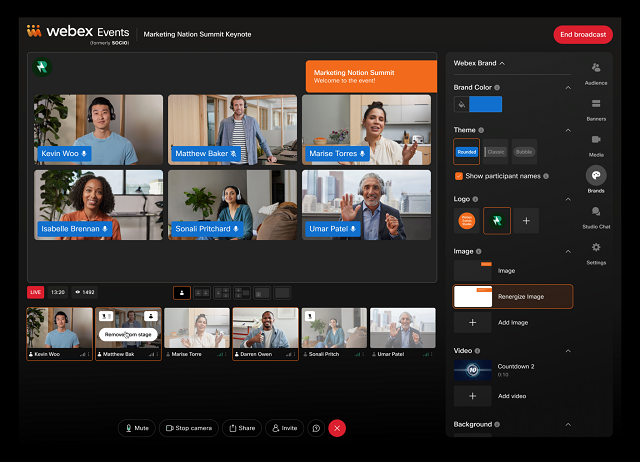
Webex Events comes from Cisco’s enterprise-grade ecosystem, and it brings that same polished feel to the event space. This is a platform built for scalability, professional branding, and complex agendas—perfect for when reliability matters more than flash.
What sets Webex Events apart in 2025 is how well it blends flexibility with structure. You can design multi-track events with detailed sponsor sections, in-depth analytics, and even gamification features—all without needing a dev team.
Custom branding is central. From pre-event pages to post-event surveys, you can shape the experience to reflect your organization’s tone and style. Sponsor booths, attendee networking, and live engagement tools round out the package.
Among the many virtual summit platforms, Webex Events holds its ground as a top-tier option—especially for enterprise organizations and global teams with complex needs. It’s not the cheapest, but it delivers on professionalism and scale.
5. Airmeet
If your event thrives on conversation, not just content, Airmeet is one to watch. Built for community-driven experiences, it emphasizes interaction over presentation. It’s ideal for workshops, education sessions, bootcamps, and any event where attendees want to meet, not just watch.
Airmeet’s virtual “tables” create space for networking, casual chats, or breakout workgroups. Speed networking, emoji reactions, and host controls make the experience feel less like a broadcast and more like a real event.
For organizers, setup is relatively easy. You can brand the event space, configure sessions, and even run ticketing without outside tools.
Among today’s virtual conference hosting services, Airmeet stands out for making events feel human—even through a screen. It’s less suited for rigid, formal conferences but shines when your audience wants to connect and collaborate.
6. BigMarker
BigMarker walks the line between webinar software and full-blown event platform. It’s ideal for marketers who want to turn webinars, demos, and online conferences into lead-generating machines.
At its core, BigMarker combines video hosting with marketing automation. You get features like built-in landing pages, email funnels, CRM integrations, and branded registration flows. That makes it a smart pick for companies running multiple small-to-medium events throughout the year.
Use cases range from training sessions to product launches and customer education events. Unlike some platforms that focus only on the attendee experience, BigMarker gives equal attention to the behind-the-scenes workflows—so your team can promote, manage, and follow up without jumping between tools.
While it may not be the flashiest on the market, it’s reliable and purpose-built for B2B marketers who need results, not just viewers. It’s a solid option in any serious virtual conference platform comparison, especially for lead-focused teams.
7. vFairs
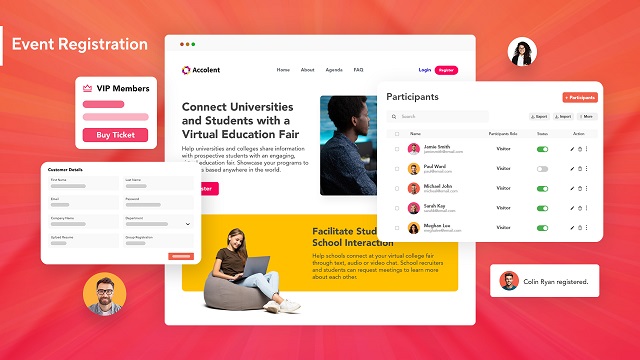
vFairs is built for virtual trade shows, expos, and career fairs—any event that relies heavily on booths, branding, and lots of concurrent conversations. It’s highly visual, with 3D lobbies, interactive exhibit halls, and customizable avatars that make the experience feel more like a digital venue than a basic webinar tool.
What sets it apart is the flexibility in design. You can replicate a branded convention center, organize content by theme, and give sponsors plenty of space to shine. Attendees can browse booths, download resources, chat with reps, and schedule follow-ups—all in one interface.
That said, it comes with complexity. Setup time is longer, and there’s a learning curve for new organizers. But if visual impact matters and your audience expects a “wow” factor, vFairs delivers.
Among conference hosting platforms, vFairs is an excellent fit for large, content-heavy events where first impressions—and sponsor impressions—really count.
8. HeySummit
HeySummit doesn’t try to be the biggest. Instead, it’s built for creators, coaches, and solo professionals running small, highly targeted online summits. If you’re running a niche event with a few guest speakers, gated content, and live or pre-recorded sessions, this platform gets the job done—without the bulk.
Its strength lies in simplicity. The interface is clean, the speaker onboarding is smooth, and it handles things like ticketing, registration pages, and session scheduling out of the box. You won’t need to patch together multiple services just to go live.
The platform is best for lightweight operations—people who care more about launching quickly and managing a focused audience than building an elaborate expo. Among virtual conferences platforms, it’s one of the easiest to start with, especially if you’re a team of one.
It won’t scale to massive multi-track summits, but for small events with clear messaging and a loyal following, HeySummit is more than enough.
9. ON24
ON24 is one of the few platforms on this list that was built with enterprise marketing in mind. It’s not just about hosting events—it’s about converting attendees into customers and nurturing those leads long after the webinar ends.
The platform excels in analytics and content lifecycle tools. It tracks how users interact with every part of your event—clicks, downloads, questions, poll responses—and rolls that data into your CRM or marketing automation system. For companies focused on demand generation, ON24 is a powerhouse.
It’s best suited for enterprises running multiple campaigns and needing clear ROI. With its branded experiences, always-on content hubs, and multi-session events, it works well for both live and on-demand events.
In virtual conference platform comparison, ON24 stands out for large organizations that need rich data, integration with existing tech stacks, and serious lead-gen capabilities.
10. Run The World
If most platforms feel like enterprise software, Run The World feels like a social app that hosts events. It’s light, fast to launch, and geared toward casual, high-energy gatherings like interactive panels, community chats, or expert roundtables.
The interface is fun, mobile-first, and made for audience participation. Features like cocktail-style speed networking, reactions, and co-hosted sessions help make virtual events feel less lonely—and more alive.
It’s especially popular among creators, thought leaders, and startups looking to run polished events without a huge learning curve. You won’t get complex sponsor zones or deep customization, but that’s not the point. Run The World delivers simplicity and interaction, not enterprise depth.
If your priority is speed, ease, and energy—and your event leans more toward conversation than keynote lectures—Run The World makes sense. It’s not for every use case, but in the right hands, it turns virtual conferences platforms into something genuinely engaging.
Need Something More Tailored? A Custom-Built Alternative from Scrile Meet

Even with all the polished platforms on the market, not every use case fits neatly into a pre-built box. For some businesses—especially those in consulting, coaching, healthcare, education, and wellness—the off-the-shelf tools feel either too bloated or too limited. They need something else: ownership, control, and the ability to build exactly what fits their audience.
That pressure to “get it exactly right” exists because virtual events are no longer side projects. As event specialists at EventBuilder put it:
In summary: They’re now a staple in the event planner’s toolkit, offering a unique blend of accessibility, engagement, and measurable results.
If virtual conferences are becoming a staple in your own toolkit, it often makes sense to own the underlying platform. That’s where a solution like Scrile Meet stands out: instead of renting generic event software, you’re investing in a branded system that can evolve with your format and business model.
That’s where Scrile Meet steps in. Unlike most SaaS options, this is a turnkey software solution that lets you launch your own fully branded virtual consultation platform—no coding needed, and no platform commissions cutting into your revenue. You get the infrastructure, the features, and the design flexibility—all under your control.
Here’s what it includes:
- Private video calls, both one-on-one and group sessions
- Appointment booking with calendar integration
- Paid access to sessions or messaging
- A built-in admin dashboard to manage users, payments, and analytics
- Fully customizable UI/UX so your platform matches your brand from day one
There’s no need for downloads or native apps—it runs right in the browser and works across all devices. And crucially, your data stays yours. That’s a big deal in industries where privacy and control really matter.
Whether you’re a coach running premium sessions, a legal consultant managing client calls, or a niche educator looking to monetize expertise, Scrile Meet offers a way to own the platform instead of renting space on someone else’s.
It’s not another app—it’s the framework to build your own. If you’re thinking long-term, this isn’t just a smarter move—it’s a future-proof one.
Off-the-Shelf Platforms vs. Scrile Meet
| Option | Ownership | Branding | Features | Pricing Model | Weak Points |
|---|
| Zoom, Hopin, vFairs, etc. | Vendor-owned | Limited customization | Multi-track, sponsor zones | Subscription / per-event fee | Commission cuts, vendor lock-in |
| Lightweight Tools (HeySummit, Run The World) | Vendor-owned | Basic branding | Ticketing, live sessions | Low monthly fee | Limited scale, no deep customization |
| Scrile Meet (Custom Platform) | Full client ownership | 100% custom UI/UX | Video calls, booking, payments, analytics | One-time license + optional support | None — turnkey handled by Scrile |
How to Choose the Right Virtual Conference Platform
There’s no universal “best” tool—only the one that fits your goals. Before you commit to anything, ask yourself:
- Are you hosting a free event, or selling tickets?
- Will you need expo booths, sponsor zones, or just a few speakers and Q&As?
- Is branding a priority, or are you fine with a generic look?
- How tech-savvy is your team—and your audience?
This guide’s virtual conference platform comparison should help you match your needs to the right tools. Platforms like HeySummit work for lean solo events, while Hopin or vFairs cater to big-budget, multi-track expos. Meanwhile, if none of them give you full ownership or flexibility, building your own platform (like with Scrile Meet) might be the right path forward.
Conclusion
Choosing the right tool sets the tone for your entire event. With virtual conference platforms evolving fast, it’s smart to think ahead—not just about your next event, but the next five.
Test a few, ask for demos, explore what’s out there—and if nothing fits, consider building your own. A fully branded platform like Scrile Meet gives you long-term control, monetization options, and freedom from third-party limits.
Use this virtual conference platform comparison as your starting point, and create something that actually reflects your vision.
Polina Yan is a Technical Writer and Product Marketing Manager, specializing in helping creators launch personalized content monetization platforms. With over five years of experience writing and promoting content, Polina covers topics such as content monetization, social media strategies, digital marketing, and online business in adult industry. Her work empowers online entrepreneurs and creators to navigate the digital world with confidence and achieve their goals.

by Polina Yan
Voice recognition is no longer a future technology but now a mainstream tool in everything from healthcare and customer service to smart assistants and accessibility and automation systems. It is becoming part of everything from apps and messaging to virtual personal assistants and smart devices in the home.
One of the prime movers towards accomplishing this revolution is the swift evolution in artificial intelligence (AI) and natural language processing (NLP). Speech recognition Python-based solutions fueled by AI have evolved immensely in precision to enable real-time transcriptions, voice command recognition, and multilingual recognition.These technologies are making interactions faster and more efficient, whether it’s for virtual assistants like Siri and Alexa, medical transcription services, or automated customer support systems.
Why Python Speech Recognition?
Among the many programming languages used for voice recognition, Python speech recognition stands out as the top choice for developers. Python’s ecosystem offers several powerful libraries that allow developers to integrate speech-to-text functionalities into applications with minimal effort. Its extensive open-source community and machine learning frameworks make it the go-to language for AI-driven projects.
Here’s why Python is widely used for speech recognition:
- Rich library support – Python offers multiple dedicated speech recognition libraries, such as SpeechRecognition, DeepSpeech, and Vosk, that simplify the integration process.
- Ease and usability – Its programming syntax readability allows one to develop complex voice-based AI systems with much ease and flexibility in use
- Robust machine learning and AI features – Python has direct integration with machine learning and deep learning platforms like TensorFlow and PyTorch to enable organizations to construct highly precise, custom-built speech recognition models.
- Cross-platform compatibility – Such systems work across multiple operating systems, ensuring scalability for web, mobile, and embedded applications.
How Speech Recognition Works in Python

Speech recognition enables machines to understand and process spoken language, converting it into readable text or commands. The tech can also provide voice assistants, in-home devices, automated transcription tools, and voice-free systems. Such systems can be developed in a less complicated way through developments in Python speech recognition and with the aid of sophisticated AI-based tools.
Human speech recognition includes both linguistic processing and machine learning models being used correctly in a very complicated process.
At its core, speech recognition isn’t magic — it’s about turning complex sound patterns into understandable language using advanced models. Modern systems often rely on neural networks and deep learning to improve accuracy far beyond simple dictionary matching.
“Whisper is a machine learning model for speech recognition… capable of transcribing speech in English and several other languages, and… improved recognition of accents, background noise and jargon compared to previous approaches.”
— OpenAI on Whisper (speech recognition system), Wikipedia
That’s why libraries like Whisper, DeepSpeech, and Vosk form the backbone of Python speech projects — they leverage modern machine learning architectures to decode human speech in ways older systems could not.
Key Components of Speech Recognition Python Applications
- Acoustic Modeling. Speech consists of phonemes, which are the fundamental units of sound. The AI systems identify these sounds and match them to their corresponding letters or syllables. Acoustic models enable the recognition of words that sound alike and handle the variations in pronunciation.
- Language modeling. The system then has to organize words and sentences in a coherent order after sensing phonemes. Prediction models enhance recognition by predicting words that most likely follow in a sentence in largely the same manner that autocorrect or predictive input works in cell phones.
- Noise Filtering & Audio Processing. Recognition of speech is not only about recognizing words—participating words must be filtered from ambient noise and sound. Most speech recognition Python libraries come with noise cancellation to enhance the performance in real scenarios, i.e., in the office, in a crowd, or in the context of in-car free hand conditions.
Neural Network Processing. They have the latest speech recognition systems using AI and deep models to improve accuracy levels. Advanced deep models and AI assist the systems in identifying patterns in enormous amounts of spoken data to adapt to accents and dialects and patterns changing with time.
Top Python Speech Recognition Libraries in 2025
Python offers a variety of powerful speech recognition libraries, each suited for different use cases. Whether you need a lightweight API-based tool, an offline speech recognition system, or an advanced deep learning model, there’s a solution available. Below is a comparison of the five best speech recognition Python tools in 2025, covering their strengths, weaknesses, and ideal use cases.
Comparison of Top Python Speech Recognition Libraries
| Library | Type | Strengths | Weaknesses | Best For |
|---|
| SpeechRecognition | Wrapper for multiple APIs | Easy to use, lightweight, flexible, supports Google/IBM/Microsoft | Internet dependent, weak offline support | Quick integration, basic transcription |
| Mozilla DeepSpeech | Offline, open-source, TensorFlow-based | High accuracy, customizable, privacy-friendly | Needs GPU/high CPU, large models | Privacy-sensitive apps, custom AI |
| Vosk | Offline, lightweight | Low latency, multilingual, works on embedded devices | Limited pre-trained models, requires tuning | IoT, Raspberry Pi, smart devices |
| Google Speech-to-Text API | Cloud-based | Very accurate, real-time streaming, auto-punctuation | Subscription costs, needs internet, latency risk | Enterprises, live transcription, call centers |
| OpenAI Whisper | AI-powered, multilingual | Extremely high accuracy, understands accents & noise, context-aware | Heavy resource use, slower on low hardware | Journalism, podcasts, multilingual assistants |
SpeechRecognition

SpeechRecognition is one of the most widely used Python libraries for speech-to-text conversion. It acts as a wrapper for multiple speech recognition engines, making it easy to integrate with cloud-based and offline services. The library supports APIs like Google Web Speech, CMU Sphinx, IBM Speech to Text, Wit.ai, and Microsoft Azure Speech.
Strengths:
- Easy to implement – Requires minimal setup and works with a simple API call.
- Lightweight – Does not require extensive computational power.
- Flexible – Supports multiple speech engines, allowing developers to choose the best fit.
Weaknesses:
- Internet dependency – Most of its features rely on cloud APIs, requiring an internet connection.
- Limited offline capabilities – The CMU Sphinx engine is available for offline use but lacks accuracy compared to deep learning-based alternatives.
Best Use Cases:
- Quick speech recognition integration into Python applications.
- Developers looking for a simple API to access Google or IBM speech services.
- Basic transcription needs where internet access is available.
Mozilla DeepSpeech
Mozilla DeepSpeech is a deep learning-based, open-source speech recognition system built on TensorFlow. It is trained on thousands of hours of voice data and offers high accuracy, even in challenging conditions. Unlike cloud-based solutions, DeepSpeech runs entirely offline, making it suitable for privacy-sensitive applications.
Strengths:
- Fully offline processing – No internet connection required.
- High accuracy with proper training – Can be fine-tuned with custom voice data.
- Open-source flexibility – Developers can modify and improve models based on their needs.
Weaknesses:
- Requires high computational power – Best suited for systems with GPUs or high-end CPUs.
- Large model size – Can be resource-intensive compared to lightweight libraries like SpeechRecognition.
Best Use Cases:
- Privacy-focused applications that require offline speech recognition.
- AI-driven applications needing accurate speech-to-text conversion.
- Developers looking to fine-tune a speech model for a specific use case.
Vosk
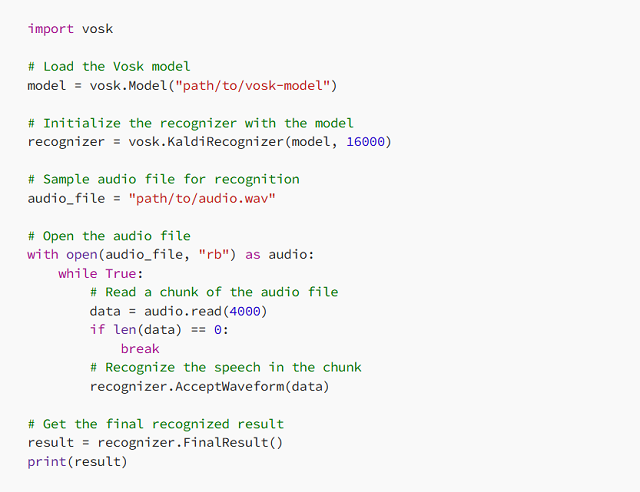
Vosk is a lightweight, offline speech recognition Python library designed for low-power devices like Raspberry Pi and embedded systems. It supports multiple languages and provides real-time speech processing with minimal resource consumption.
Strengths:
- No internet dependency – Works completely offline.
- Low latency – Optimized for real-time applications.
- Multilingual support – Recognizes speech in over 20 languages.
Weaknesses:
- Fewer pre-trained models compared to cloud-based APIs.
- Requires additional tuning to improve accuracy for niche applications.
Best Use Cases:
- Embedded systems (Raspberry Pi, IoT applications, smart home devices).
- Developers needing offline speech recognition with minimal hardware requirements.
- Multilingual speech processing for global applications.
Google Speech-to-Text API
Google Speech-to-Text API is a cloud-based speech recognition service that provides highly accurate transcription using Google’s deep learning models. It supports real-time and batch processing, making it suitable for applications requiring fast and scalable speech recognition.
Strengths:
- High accuracy across multiple languages.
- Supports real-time streaming for live applications.
- Includes auto-punctuation and noise cancellation features.
Weaknesses:
- Requires a Google Cloud subscription, which can be expensive for high-volume applications.
- Latency issues may arise in environments with poor internet connectivity.
Best Use Cases:
- Large-scale enterprise applications needing cloud-based transcription.
- Call centers and customer support automation.
- Live streaming applications requiring real-time speech-to-text conversion.
OpenAI Whisper
OpenAI Whisper is an AI-powered speech recognition Python model trained on a massive dataset of multilingual speech. It is designed for high-accuracy transcription, multi-language support, and natural conversation understanding.
Strengths:
- Extremely high accuracy, even with accents and noisy backgrounds.
- Supports multiple languages, making it ideal for global applications.
- AI-driven transcription with improved contextual understanding.
Weaknesses:
- Requires significant processing power for real-time applications.
- Can be resource-intensive compared to lightweight libraries.
Best Use Cases:
- High-accuracy transcription services for podcasts, interviews, and journalism.
- AI-driven voice assistants with multilingual capabilities.
- Businesses needing contextual understanding beyond simple speech-to-text conversion.
Python continues to be a leading choice for developing speech recognition applications due to its extensive library support. Whether you need a simple API-based tool like SpeechRecognition, an offline solution like Vosk, or an advanced AI-powered model like OpenAI Whisper, there is a Python speech recognition library suited for your project.
Choosing between open‑source libraries and cloud‑based speech APIs isn’t just a technical decision — it’s a strategic one. The tradeoffs often come down to control versus convenience.
“Open-source solutions… offer the flexibility to modify the code to meet specific requirements. However, open-source solutions… must be provided and managed by you… Additionally, the accuracy of open-source tools is often inferior to that of cloud-based alternatives…”
— AssemblyAI, “Python Speech Recognition in 2025”
This highlights why many developers start with an API like Google Speech or AssemblyAI for accuracy and then graduate to local, customized systems when they need more control, privacy, or offline capability.
How to Implement Python Speech Recognition in Your Project

Python speech recognition systems have made changing the way that companies automate processes, communicate with users, and process voice data a reality. From virtual assistant-based systems powered by artificial intelligence to voice command and real-time transcription and voice-controlled smart devices, application utilization of speech recognition must be weighed and optimized.
To successfully implement Python speech recognition technology, firms have to select the right library, calibrate processing to realworld specifications and integrate the tool into the process. High accuracy cloud-based APIs are required in some applications while independent and offline models work in others
The secret to an effective speech recognition Python project is finding the ideal balance between accuracy and speed and being in a position to connect well with other systems.
Setting Up a Python Speech Recognition System
Before diving into implementation, it’s important to define what the speech recognition system will be used for. A real-time transcription service requires high-speed processing, whereas an AI chatbot might need natural language understanding in addition to voice-to-text conversion.
Once the use case is clear, the next step is setting up the development environment. This involves installing the necessary Python libraries and configuring the system for optimal performance.
Cloud-Based vs. Offline Speech Recognition
One of the first decisions businesses face when implementing Python speech recognition is whether to use cloud-based or offline speech processing.
Cloud-based services, such as Google Speech-to-Text or OpenAI Whisper, provide high accuracy and continuous improvements because they leverage deep learning models trained on massive datasets. These services are ideal for applications that require real-time, multilingual speech recognition. However, they depend on an internet connection and often come with ongoing usage costs.
Offline models, like DeepSpeech and Vosk, process voice data directly on the device, making them a great choice for privacy-sensitive applications where data security is a concern. These solutions allow businesses to avoid external API costs, but they may require fine-tuning and additional computational resources for training and optimization.
For businesses operating in high-security industries, such as healthcare, finance, and legal services, offline models provide greater control over voice data without relying on third-party providers.
Optimizing Speech Recognition for Accuracy and Performance
The speech recognition model is as good as the quality input it gets. Even the most advanced AI-based systems fail to handle poor quality audio, high levels of background noise, or heavy accents. To have a better recognition percentage, companies need to work on sound optimization and model adjustment from the AI end
Major factors affecting accuracy in speech recognition:
- Audio Quality – High-quality microphones and noise elimination methods enhance speech audibility and produce better transcription accuracy.
- Background noise management – Using sound filtration and noise cancellation techniques enables speech models to tune in to the voice of the speaker
- Speaker Adaptation – Training models to recognize multiple accents and speaking patterns ensures higher accuracy to multiple clusters of users
- Word Choice Within Domain – Training models to a domain-specific lexicon increases awareness to business-specific usage
For multiple language applications, multiple language support will be required. There exist Python speech recognition libraries that natively support multiple languages and those that allow multiple language support through changing between multiple models trained in different languages. Business organizations that have international scope should prefer solutions with robust language processing
Integrating Speech Recognition into Business Applications
Speech recognition technology is now being widely adopted across various industries, providing businesses with new opportunities for automation and customer interaction. The implementation of this technology depends on the specific use case and industry requirements.
depends on the specific use case and industry requirements.
Real-World Business Applications of Python Speech Recognition:
- AI-powered Customer Service – Virtual and AI-powered chatbots utilize speech recognition to comprehend the inquiries of the customers and respond automatically.
- Medical Transcription Services – Physicians would not be depending on speech-to-text systems to auto-document along with note-taking.
- Financial & Legal Transcription – It reduces paperwork in financial reports and legal cases and client conversations
- Hand-Free devices for Smart devices – Devices with IoT such as voice assistant smart home devices and voice command in vehicles use voice recognition to offer hand-free services.
- Live Captioning & Subtitling – Automatic transcription tool helps organizations produce live captions in real-time online conferences, webinars, and live streams.
Each of these use cases requires different levels of accuracy, latency, and language processing capabilities, making it essential to choose the right speech recognition Python solution for the job.
Ensuring Scalability and Security in Speech Recognition Applications
Scalability is a paramount concern for businesses handling vast volumes of voice data. A speech recognition system must be capable of handling thousands of interactions simultaneously without compromising speed or accuracy.
Security is also an important concern, particularly when dealing with sensitive user data. Some industries, such as finance, healthcare, and government, must comply with strict data privacy regulations like GDPR and CCPA.
To ensure compliance, businesses should consider:
- On-premises speech recognition solutions for greater control over data.
- End-to-end encryption for protecting voice interactions.
- AI bias mitigation to prevent inaccuracies based on speaker demographics.
Balancing performance, security, and cost-efficiency is essential for businesses that rely on AI-powered speech recognition for mission-critical applications.
Challenges and Limitations of Speech Recognition
While Python speech recognition has advanced significantly, real-world implementation comes with several challenges that affect accuracy, speed, and user experience. Companies implementing speech-to-text solutions need to overcome technical constraints to support fluent and seamless functioning.
Background noise is one of the biggest issues. In noisy environments like offices, public spaces, and call centers, speech recognition models struggle to distinguish the speaker’s voice from background noises, simultaneous conversations, or echoing acoustics.This leads to continuous misinterpretations, which makes the system less reliable.
Another challenge is dialect and accent recognition. While many speech recognition Python models are trained on standardized datasets, they often fail to accurately process regional accents, fast speech, or non-native pronunciations. This can result in incorrect transcriptions or repeated errors, making the system frustrating for diverse user groups.
Latency is another concern, particularly for real-time speech recognition applications. Systems requiring real-time voice-to-text transformation, such as AI chatbots or live transcription software, need to maintain processing latency as low as possible. High latency can make interactions respond slowly or become unresponsive, affecting user experience in a negative manner.
To overcome these limitations, businesses optimize their speech recognition models using noise reduction filters, AI-powered learning, and continuous model fine-tuning. By adapting speech recognition Python solutions to real-world conditions, companies can significantly improve accuracy and performance.
Scrile AI: The Best Custom Development Service for Python Speech Recognition
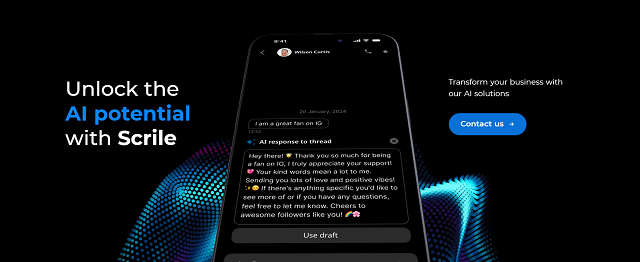
Businesses looking to implement speech recognition Python solutions need more than just an off-the-shelf API—they need a customized, scalable, and efficient system that seamlessly integrates with their existing workflows. Scrile AI offers a tailored approach to speech recognition development, ensuring that businesses get precisely the features, accuracy, and performance they need.
Contrary to typical cloud-based applications limiting personalization and control, Scrile AI provides fully customized speech recognition models, designed for industry-specific use. Customer service automation, medical transcription, legal documentation, or voice-based smart apps, Scrile AI provides cutting-edge AI solutions on the basis of proprietary business requirements.
Why Choose Scrile AI Over Off-the-Shelf Solutions
| Option | Ownership | Customization | Security | Scalability | Integration | Weak Points |
|---|
| Off-the-Shelf APIs (Google, IBM, etc.) | Belongs to provider | Limited, generic models | Provider-dependent compliance | Scales with cost | Easy to plug & play | Vendor lock-in, recurring fees |
| Open-Source Models (Vosk, DeepSpeech, Whisper) | Open community | High, but requires expertise | Depends on implementation | Flexible, but resource heavy | Needs dev effort | Requires AI/ML specialists |
| Scrile AI (Custom Python Development) | Full client ownership | Tailored to industry (medical, legal, finance, support) | GDPR/CCPA compliant, business-grade | Enterprise-level, low-latency, live-ready | Seamless integration into existing apps | None — handled as turnkey by Scrile |
What Scrile AI Offers
Scrile AI specializes in custom-built AI solutions, allowing businesses to leverage advanced Python speech recognition technology while maintaining complete ownership and flexibility over their systems.
- Custom speech recognition models – Tailored for specific industries to give higher accuracy in specialized vocabulary and use cases.
- Seamless integration – Integrates with existing apps, software environments, and backends without problems of compatibility.
- Scalable infrastructure – Designed to process live voice handling with high-speed transcription and low latency.
- Multilingual speech recognition – Supports multiple languages and dialects, making it ideal for global businesses.
Why Choose Scrile AI Over Off-the-Shelf Solutions?
The majority of companies begin with third-party APIs but later discover that pre-existing solutions are significantly limiting. Scrile AI escapes vendor lock-in and platform limitations and offers:
- End-to-end bespoke AI models – No reliance on third-party, and thus companies will fully own their technology.
- Business-class security – GDPR, CCPA, and other data privacy law compliant, hence secure and safe voice data processing.
- Support and scalability – Engineered for businesses who need long-term stability, upkeep, and nurturing for mass scale operations.
For businesses serious about building powerful, AI-driven voice solutions, Scrile AI provides the best Python speech recognition development service available. Explore Scrile AI’s custom AI solutions today and bring advanced speech recognition capabilities to your business.
Conclusion
The landscape of Python speech recognition is evolving rapidly, with numerous libraries that offer advanced features for real-time transcriptions, AI assistants, and voice automation. The choice of the appropriate tool depends on your needs, levels of accuracy, and scalability objectives.
For businesses that require custom solutions, relying on pre-built APIs may not be enough. Scrile AI provides tailored AI development, ensuring full control, security, and seamless integration into any application.
Take the next step—explore Scrile AI today and build a custom AI-powered speech recognition Python system.
Polina Yan is a Technical Writer and Product Marketing Manager, specializing in helping creators launch personalized content monetization platforms. With over five years of experience writing and promoting content, Polina covers topics such as content monetization, social media strategies, digital marketing, and online business in adult industry. Her work empowers online entrepreneurs and creators to navigate the digital world with confidence and achieve their goals.

by Polina Yan
The subscription content economy is exploding. Creators are earning serious money, and fans are paying for access, not ads. It’s a shift in how content is valued — and who controls the revenue.
An OnlyFans clone isn’t a knockoff. It’s a self-owned, custom-built version of the same monetization model: monthly subscriptions, pay-per-view drops, tipping, private messages — but all under your branding. You keep 100% of what you earn. Platforms can’t ban you overnight. Your visibility doesn’t depend on algorithms.
This model works especially well in adult content, where mainstream platforms still refuse to support creators openly. But it’s also growing into adjacent spaces: fitness, coaching, fandoms — and now, the adult NFT marketplace. Tokenized content and gated drops are finding a home inside clone platforms built for flexibility.
2025 isn’t just a good time to launch. It’s the right time. The infrastructure is there. The demand is there. What’s missing is your own name on the door.
Let’s walk through how to build your own platform — and why 2025 might be the best time to do it.
Don’t Just Copy: Understand Why OnlyFans Took Off

OnlyFans didn’t go viral because of some flashy UI. It exploded because it gave creators power. They set the price, controlled the content, and got paid directly — no middlemen, no censors, no platforms pulling the plug.
The rise of OnlyFans wasn’t accidental. It matched a cultural shift: people were ready to pay for access. Real access. Unfiltered, direct, often NSFW. Fans didn’t want mass-produced, ad-funded content anymore. They wanted something personal. And they were happy to tip for it.
An OnlyFans clone needs to capture that same logic — not just clone the layout. Behind every feature is a reason it works:
- Subscriptions reward consistency
- Tips reward moments of connection
- PPV messages unlock curiosity
- Anonymity removes friction
- Exclusivity fuels retention
According to Influencer Marketing Factory report, the creator economy crossed $21 billion in revenue in 2023 — and that’s just reported income. Much of it came from platforms that embraced fan-funded content instead of fighting it.
So before you start hunting for OnlyFans clone scripts or rushing into design mockups, zoom out. Ask why this model worked in the first place. And how your platform can do it better — for your niche, your audience, and your brand.
Cloning success means cloning strategy — not just software.
Core Features You’ll Need — No Fluff
When building an OnlyFans clone, you don’t need gimmicks. You need fundamentals that work, scale, and keep both creators and fans active. Many clones fail because they either overload the site with features nobody uses or ignore the backend that makes things stable. Your goal should be to build something lean, secure, and efficient from day one.
Here’s a breakdown of the non-negotiable core features:
- Subscription tiers — Flexible pricing options let creators offer entry-level access, premium exclusives, and VIP perks. This boosts retention and gives fans choices that match their budget.
- Creator dashboards — Let creators manage content, track earnings, schedule posts, and set custom pricing without jumping through hoops.
- Payout systems — Timely, transparent, and multi-currency payment support is critical. If creators can’t get paid easily, they won’t stick around.
- Messaging and media locking — Direct DMs, pay-to-unlock messages, locked photo galleries, and video paywalls are must-haves for monetization and engagement.
- Tipping and pay-per-view — Fans love spontaneous support. A tip jar, reaction buttons, or one-time paid content helps creators make more from every interaction.
- Live streaming — Live video isn’t optional anymore. Streamed events, private calls, or group shows give creators a way to connect and earn in real time.
- Mobile-first UX — Most users will access your site via phone. The interface has to feel smooth, responsive, and intuitive on any screen size.
- Security and moderation tools — Include ID checks, content watermarks, age verification, and built-in moderation controls to avoid legal risks and protect creators.
You’re not just serving one user group. Creators need autonomy over their work, while fans need seamless access and payment options. If your site frustrates either side, you’ll lose both. Balance matters. Prioritize usability, speed, and reliability before even thinking about advanced features.
Revenue Streams to Stack

An OnlyFans clone that depends on subscriptions alone is leaving money on the table. Subscriptions are your foundation, but serious income comes from everything built around them. When creators have multiple ways to earn, retention goes up — and so does average revenue per user.
An OnlyFans-style platform only works when subscriptions are just the entry point, not the whole business model. Analysts looking at OnlyFans itself keep stressing that its power comes from combining multiple revenue mechanics, not relying on a single paywall.
“OnlyFans has matured into a global case study in how creators monetize attention. Subscriptions, PPV, bundles, and collabs form the commercial engine”
— Influencer Marketing Hub, “The Monetization Mechanics of OnlyFans”
When you design your clone, treat this as a blueprint. The more intelligently you combine subscriptions, PPV, bundles, and collabs for your niche, the more resilient and scalable your revenue stack becomes.
Let’s break down the essential revenue streams you need to bake into your build from day one:
- Pay-per-view content (PPV): One-time unlocks for premium videos or photos. Great for new followers who aren’t ready to commit to a monthly fee.
- Bundles and collections: Let fans buy sets of content at a discount. This works especially well for themed drops or behind-the-scenes series.
- Tip-to-unlock media: Hidden messages, special content, or reactions that only show after a tip. Adds exclusivity and gives fans a reason to engage.
- Private messaging fees: Charge per message or open up VIP inbox access for top-tier fans. Direct interaction is the number one reason many fans pay.
- Referral incentives: Reward users who bring in new subscribers. This builds loyalty and turns fans into brand promoters.
- Live streaming with paid interactions: Let creators stream directly from their dashboard and charge for live shoutouts, private moments, or interactive games.
- NFT content licensing: This is growing fast in the adult nft marketplace. Selling NFT-tagged videos or images with proof of ownership gives creators new monetization angles — and fans something rare to own.
- Smart contracts for royalties: Especially with NFT content, smart contracts allow creators to earn every time their work is resold or licensed.
A clone that supports all these isn’t just modern — it’s future-proof. And if you’re launching in 2025, you should be aiming for that kind of edge.
Clone Scripts vs Custom Builds
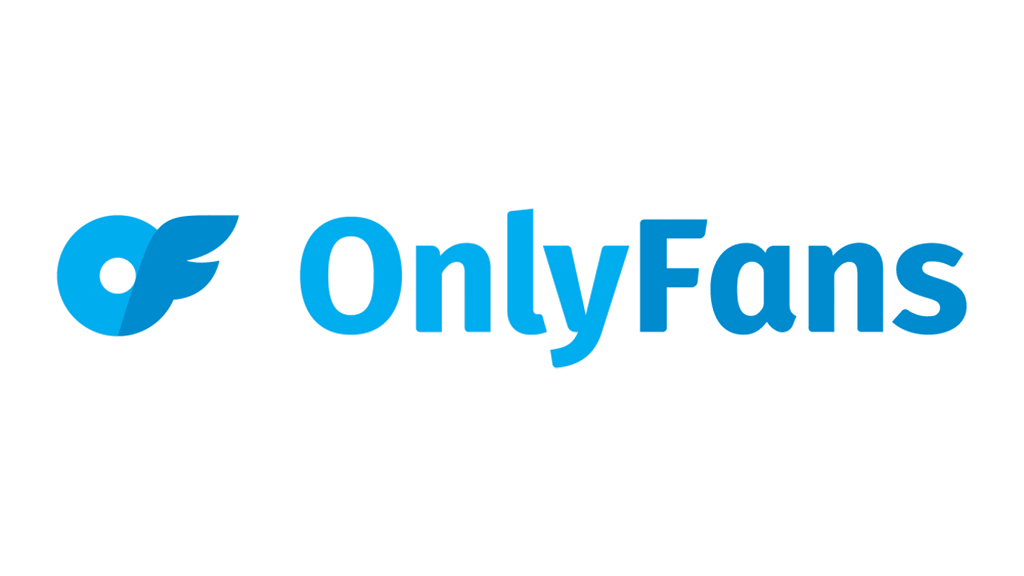
Let’s get one thing straight: a clone script is not the same as a real business infrastructure. It’s a shortcut — a prebuilt chunk of code designed to mimic another platform’s functionality, usually for a low price and with minimal effort. Most OnlyFans clones you see out there? Scripts. And while they look good on day one, the cracks show fast.
At first, a script might seem like a smart move. Fast launch, low cost, plug-and-play interface. But once creators start uploading content, fans begin subscribing, and money starts flowing — things change. Performance issues pop up. Customization hits a wall. Security gets shaky. You realize you’re stuck with someone else’s backend logic, and the only way out is a rebuild.
Why Scripts Break Under Pressure
Scalability is usually the first casualty. Scripts aren’t built for real traffic. A few thousand users can turn your site into a lagging mess. Branding is another major roadblock — try turning a cookie-cutter layout into something people remember. You won’t. And then there’s the legal headache: some clone scripts lift code too literally from the source, putting you at risk the moment lawyers start looking.
The truth is, building a lasting Only Fans clone means investing in a system that can evolve. One you can fully own, expand, and control — from payment logic to user flow. Not one that locks you into someone else’s limitations. If your business model is serious, your tech stack has to be too.
You’re not here to mimic but to monetize. And scripts don’t build sustainable ecosystems — they build headaches disguised as platforms.
Get Clear on Niche and Brand

Every successful OnlyFans clone starts with one thing — focus. Pick a clear audience and design every part of your site around them. Don’t aim wide. Aim deep. A strong niche builds stronger loyalty than a generic “all-creators-welcome” approach.
Some of the most active segments today include:
- Couples creating interactive content together
- Fetish communities looking for secure, custom content access
- Fitness creators offering exclusive plans and live coaching
- Cosplayers blending fan service with exclusive behind-the-scenes clips
Your niche defines your identity. Use it to shape your branding, tone, and feature set. Choose colors, language, and layouts that resonate with the people you want to attract.
Trust follows clarity. If users feel like the platform reflects their world, they’ll stick around. That applies to both fans and creators.
Plenty of OnlyFans clones launched without direction and vanished. One fitness-creator-focused clone tried pivoting into crypto, then gaming, then dating — and lost its core base in the process.
Don’t build something for “everyone.” Build something real for a community that needs it.
That’s exactly how sustainable creator businesses grow: not by trying to please everyone, but by serving a very specific group extraordinarily well. One of the earliest people to articulate this mindset for creators was writer and editor Kevin Kelly.
“To be a successful creator you don’t need millions.”
— Kevin Kelly, “1,000 True Fans”
An OnlyFans clone works on the same principle. If your platform helps a focused group of creators earn well from their true fans, you don’t need mass-market scale to build a serious business.
Compliance, Privacy, and Payouts

If you’re building an OnlyFans clone, legal and financial compliance isn’t something to figure out later. It’s baked into the foundation from day one.
Start with age verification. For adult platforms, this isn’t optional — it’s the law. Use trusted age-check providers and make sure content uploads follow 2257 record-keeping requirements. If you skip this, you’re one flagged video away from getting booted off your host.
Tax compliance matters, too. Creators expect accurate payouts, and governments expect reporting. Use tools that handle multi-country tax rules or integrate with services that do.
Privacy is another major trust factor. Set up secure hosting. Add masked payment systems to protect fan identities. Give creators the option to remain anonymous on payment records. These steps aren’t just for peace of mind — they directly affect signups and retention.
Now, let’s talk payouts. Adult sites get rejected by major processors all the time. Even if you’re fully legal, banks and services like PayPal might blacklist you. You need crypto-friendly gateways or merchant services that support high-risk industries.
Choose processors with clear adult industry terms. Build crypto options in from the start. Give users choices — and make sure creators get paid on time, every time.
⚖️ Clone Scripts vs. Scrile Connect
| Feature | Clone Scripts | Scrile Connect (Custom Build) |
|---|
| Ownership | No — tied to vendor’s code, branding limits | Yes — full backend control & white-label branding |
| Scalability | Struggle with high traffic, lag under load | Built to scale for thousands of users & streams |
| Monetization | Basic (subscriptions, tips) | Advanced: PPV, live streaming, pay-per-minute, NFTs, affiliate tools |
| Security & Compliance | Weak moderation & limited KYC/age checks | End-to-end: ID verification, anti-piracy, 2257 compliance |
| Payments | Risk of processor bans, few gateway options | Adult-friendly gateways + crypto integration |
| Customization | Limited templates, difficult to expand | 100% custom UI/UX, features matched to your niche |
| Long-Term Value | Short-term launch, frequent rebuilds needed | Future-proof, fully owned business asset |
Scrile Connect: Build a Clone That’s Yours

If you want to build a real OnlyFans clone — not just rent someone else’s script — Scrile Connect is the smart way in. It’s not a boxed product or a no-code app builder. It’s a development service tailored to your needs, goals, and audience — especially if you’re entering the adult industry.
Content entrepreneurs have been warning about this for years. If all your revenue depends on someone else’s product decisions, policies, or fragile script, your “business” can disappear the moment that foundation shifts.
“Do Not Build Your Content House on Rented Land.”
— Joe Pulizzi, “Find Your People, Sharpen Your Edge: Why Community + Tilt = Real Momentum”
A custom OnlyFans clone built with Scrile Connect follows the opposite logic. Instead of renting a brittle, generic script, you’re investing in a platform that you fully own, control, and can evolve with your creators and audience over time.
With Scrile Connect, you’re not bound by someone else’s branding or limited feature set. You launch under your own name, with full backend control and a frontend that looks and behaves exactly how you want. This is your site, your rules, your business.
Here’s what Scrile Connect delivers:
- Fully custom builds — not templates, but feature-rich websites crafted from scratch based on your requirements.
- Subscription systems — tiered plans, paywalls, free trials, and more, baked into your content flow.
- Built-in monetization — tipping, pay-per-minute streaming, pay-to-unlock content, and direct fan support.
- Live chat and private sessions — creator-fan engagement tools that go far beyond static feeds.
- Adult-ready infrastructure — hosting, streaming, and payment systems designed to withstand the strict policies of mainstream processors and platforms.
- End-to-end security — compliance, verification, and privacy tools for both creators and users.
- Advanced analytics — performance dashboards that show exactly what’s converting, trending, and making money.
With Scrile Connect, there are no forced revenue splits. No “Powered by” footers. No silent policy changes that break your business. What you build is yours — scalable, secure, and free from platform risk.
If you’re serious about launching an OnlyFans clone that you actually own, Scrile Connect is how you do it.
Conclusion
The creator economy keeps expanding — and fans aren’t just watching, they’re paying. Subscriptions, tips, unlockables, NFTs — these aren’t trends, they’re income streams. And yet, the platforms raking in billions? They’re rarely owned by the people creating the value.
There’s still space for new names. Not generic, overcrowded copies — but sharp, niche-focused, creator-owned platforms. Whether you’re building for fitness models, adult creators, cosplayers, or domme educators — a well-executed OnlyFans clone can become a serious business.
But if you want to actually earn — and scale — a $50 clone script won’t cut it. You need performance, stability, and something built to last.
That’s where custom development wins. When you own the site, you own the experience. You’re not stuck with a third-party roadmap. You’re free to monetize how you want — and pivot when the market shifts.
Contact the Scrile Connect team today and start building your own branded platform. No templates. No gatekeepers. Just a product that reflects your goals — and makes your revenue yours.
The next big name in the adult creator space isn’t another platform. It’s yours.
FAQ
What is an OnlyFans clone?
An OnlyFans clone is a custom-built site that works like OnlyFans — subscriptions, pay-per-view, tips, private messages — but it’s fully under your control. You run the brand, keep the profits, and set the rules.
What’s the difference between a clone script and a custom build?
A script is a cookie-cutter template. It’s fast and cheap, but limited. A custom build is made from the ground up — your design, your features, your roadmap. It scales, protects your brand, and gives you full ownership.
Can I include NFTs in my OnlyFans clone?
Absolutely. Many modern OnlyFans clones integrate with adult NFT marketplaces, letting creators mint, license, and sell digital content directly to fans. NFTs aren’t just hype — they’re another revenue stream that adds exclusivity and value.
Polina Yan is a Technical Writer and Product Marketing Manager, specializing in helping creators launch personalized content monetization platforms. With over five years of experience writing and promoting content, Polina covers topics such as content monetization, social media strategies, digital marketing, and online business in adult industry. Her work empowers online entrepreneurs and creators to navigate the digital world with confidence and achieve their goals.

by Polina Yan
You’re juggling five chats, a dozen emails, and three notifications that say “Just following up :)” — all before noon. That’s the chaos most people live in, and it’s exactly why AI respond to text tools have exploded in 2025. People don’t just want help writing. They want smart replies that feel like them, sent in seconds.
Fast isn’t enough anymore. The tone has to be right. The reply has to make sense. And it better not sound like a robot or a broken copy-paste.
That’s where AI comes in — not to flood inboxes with generic messages, but to help you respond like a human, faster than humanly possible.
In this article, we’re looking at five of the best tools on the market. They’re not just clever — they’re useful. They help you reply faster, better, and with less mental load. And if you’re building something bigger? We’ve got something for that, too.
AI Respond to Text — 2025 Quick Comparison
| Tool | Core Use Case | Biggest Strengths | Key Limitations | Integrations / Workflow | Pricing Snapshot* | Best For |
|---|
| Typli.ai | Fast, polished replies for email/DMs | Tone presets; quick edits; good for paste-in → reply | No live chat threads; no native messaging/scheduling | Copy/paste into inboxes; pairs with long-form writing | Freemium; paid unlocks unlimited & advanced | Solo founders, marketers, creators juggling many convos |
| AIFreeBox | One-off, no-login reply generation | 100% free; instant browser use; multiple tones | No memory/history; no integrations; not for ongoing chats | Ad-hoc web usage only | Free | Casual users, micro-biz owners testing styles |
| ChatGPT (custom GPT) | Build a tailored reply assistant | Highly customizable tone & rules; can learn your FAQs | Setup takes time; no native inbox integrations; not realtime by default | Embed via apps/zaps; use inside email/chat as helper | ChatGPT Plus for builder ($) | Creators/consultants/devs needing bespoke behavior |
| Reply.io | Sales outreach & inbound handling at scale | Detects intent; suggests stage-aware replies; CRM sync | Overkill for individuals; B2B focus; not for NSFW/fan DMs | Deep with HubSpot/Salesforce & sequences | Business tiers only | SDR teams, founders running campaigns |
| Jasper AI Chat | Brand-consistent replies & longer responses | Brand Voice memory; pulls from style guides/content | No direct inbox integrations; premium pricing | Content workflows; copy/paste into channels | Premium plans | Brand managers, creators needing consistent tone |
| Scrile AI (custom build) | Your own white-label reply system | Full control: tone, rules, NSFW filters, pay-per-reply, gateways | Requires a custom dev engagement | Integrates with your CRM, payments, apps; owns data | Project-based | Platforms, creators & startups needing branded, monetized chat |
*Indicative only; vendors change tiers often.
Why People Use AI to Respond to Texts Now

Nobody wants to spend their day typing the same sentence twenty different ways. “Thanks for your message!” turns into a full-time job when you’re managing clients, fans, or customers across platforms. That’s the whole point of using AI message reply tools — they shave hours off your week and take the edge off decision fatigue.
People aren’t just tired of typing; they’re also under pressure from rising expectations. Modern messaging benchmarks are brutal: people expect a response almost immediately, even if your team is offline. As Infobip notes in their guide on automated SMS replies:
“Customers expect near-instant replies. Automated responses meet that demand and show you’re available, outside business hours.”
— Infobip
That’s exactly where AI respond-to-text tools shine. They let you acknowledge every message, keep conversations warm, and protect your sanity — without forcing you to be glued to your screen 24/7.
But it’s not just about speed. It’s about how you sound. The way you reply defines your tone, your brand, even your income if you’re working in a chat-based business. A rushed answer can sound cold. An overlong one looks fake. AI tools can adjust that — they know when to be warm, when to be short, when to add a wink or keep it formal.
For adult content creators, NSFW chat hosts, and online coaches, this isn’t optional — it’s survival. You’re expected to respond like you’re always present. AI that responds to texts fills the gap, handling common replies or smoothing out the awkward pauses without breaking the illusion of live interaction. It’s also becoming a quiet backbone of customer support, especially for solo founders or indie operators running lean.
What you’re doing in those DMs, inboxes, or fan chats is very close to what big brands do with AI support agents. Salesforce describes these AI helpers in a way that maps perfectly to the tools you’re reviewing here:
“AI customer service agents are software programs that use artificial intelligence to interact with customers, providing automated responses to common queries,”
— Salesforce
In other words, whether you’re running fan chats, premium DMs, or lean customer support, you’re building your own version of an AI service agent. The only real difference is how much tone, logic, and monetization control you demand from your tools.
The real shift? You’re not just automating messages — you’re automating tone, energy, and attention. AI doesn’t just send a reply. It protects your bandwidth so you can focus where it counts.
That’s why people are leaning hard into this tech — not just to save time, but to stay sharp, stay personal, and stay scalable. If you’re looking for an AI reply to messages, a smarter AI response to text messages, or even a playful AI text reply tool to match your style, you’re not alone. The demand’s massive — and in the next section, you’ll see the tools leading the charge.
5 Best AI Reply Tools in 2025
Whether you’re managing fans, clients, or customers, the ability to respond quickly — without sounding robotic — is now a competitive edge. The best AI respond to text tools in 2025 don’t just spit out phrases. They get your tone, context, and intent. Let’s break down five top contenders, each with their own strengths and blind spots.
Typli.ai — Speed Meets Smart Tone
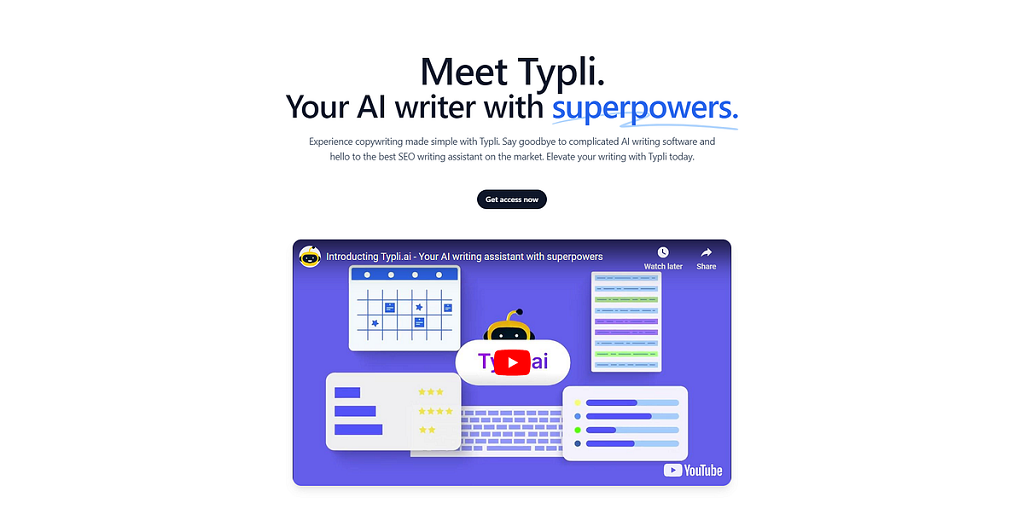
Typli.ai is more than a writing assistant — it’s built for fast, polished replies across email, social DMs, and text-based communication. Just paste an incoming message, choose a style, and Typli generates a ready-to-send reply in seconds.
Best for: Marketers, creators, and solo founders who juggle dozens of conversations daily.
Pros:
- Tone presets from formal to casual to bold
- Edits replies for clarity and impact
- Works for emails, chats, and social posts
- Seamless long-form writing integration
Cons:
- Not ideal for live chat or conversational threads
- No built-in messaging integrations
- Lacks automation or scheduling features
Pricing: Freemium with paid tiers for unlimited generations and advanced options.
AIFreeBox — Free-Use Tools with No Login Hassle
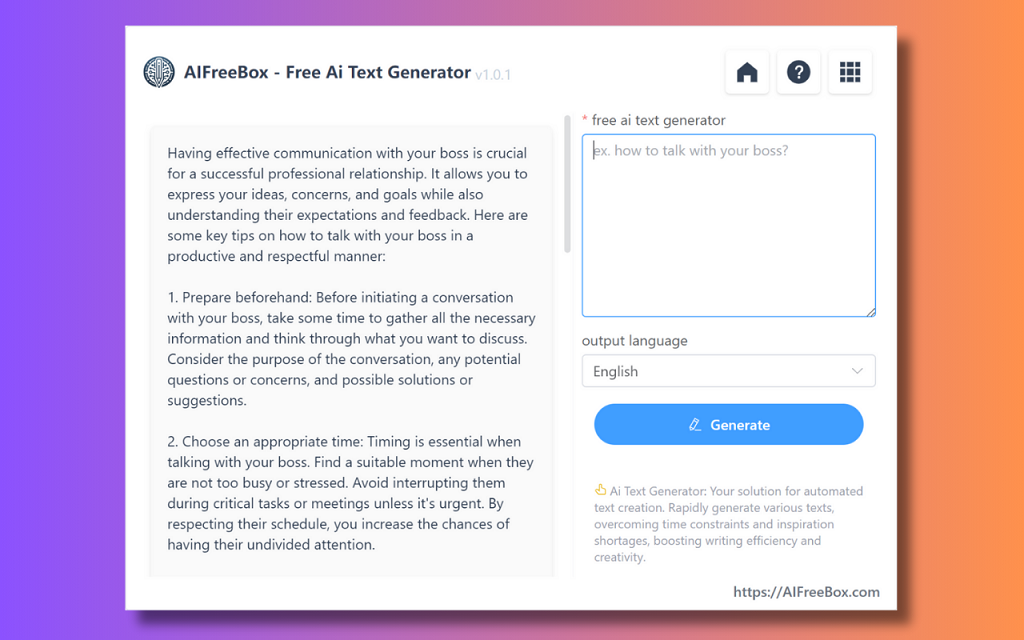
AIFreeBox offers lightweight AI responders you can use instantly — no setup, no subscription. It’s perfect when you just want to generate a quick, thoughtful reply without opening a full app.
Best for: Casual users, small business owners, or creators testing tone and style variations.
Pros:
- 100% free and browser-based
- Multiple tone options for replies
- No sign-up or installation required
- Useful for short replies and email copy
Cons:
- No memory or chat history
- Can’t integrate into real workflows
- Not suitable for ongoing customer conversations
Pricing: Completely free.
ChatGPT — Personalized AI Reply Bots on Demand
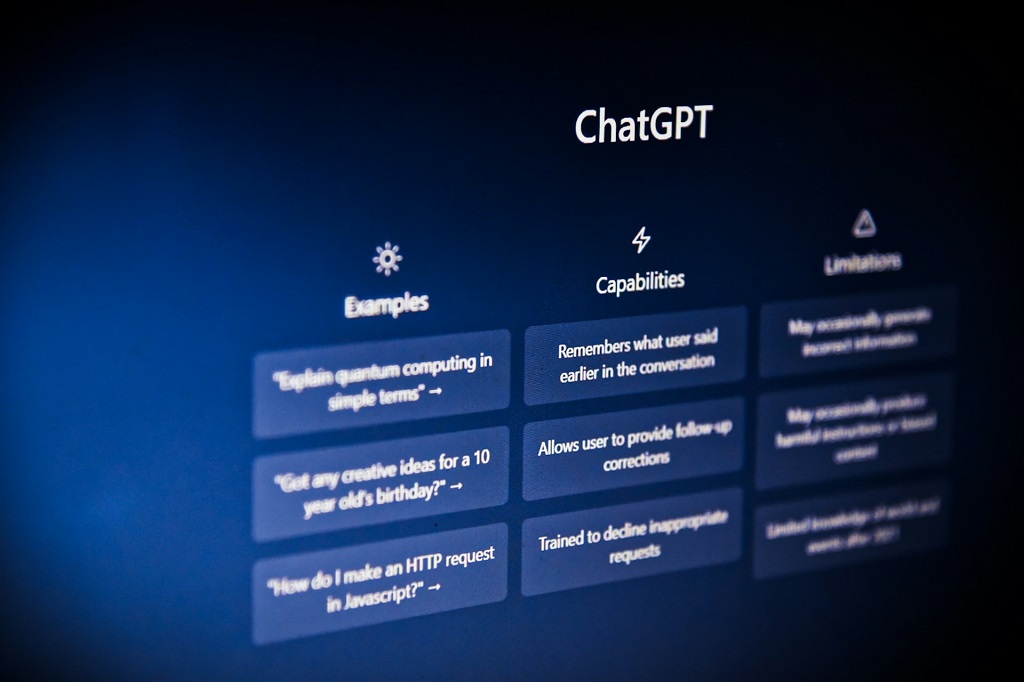
If you’re already using ChatGPT, building a custom GPT for replies is a powerful option. OpenAI now allows users to create GPT-powered bots that can be trained on specific tone, style, or even customer service flows. This makes it a favorite among tech-savvy creators, startup founders, and anyone who needs an AI reply to messages that actually reflects their voice.
You can design a reply assistant that understands your tone, your context, and your audience — whether you’re chatting with clients or managing a community. Custom instructions let you train it on FAQs, preferred phrases, and even rules for what not to say.
Best for: Creators, consultants, and developers who want to fully tailor how their replies sound and behave.
Pros:
- Fully customizable AI behavior and tone
- Can be trained on your data and rules
- Works across email, chat, or internal platforms
- Option to build NSFW or niche support bots
Cons:
- Requires some technical skill or patience to set up
- No native messaging integrations (you’ll need to embed it elsewhere)
- Doesn’t handle real-time conversations out of the box
Pricing: Included with ChatGPT Plus ($20/mo) for GPT builder access.
Reply.io — AI Outreach and Smart Replies for Sales Teams
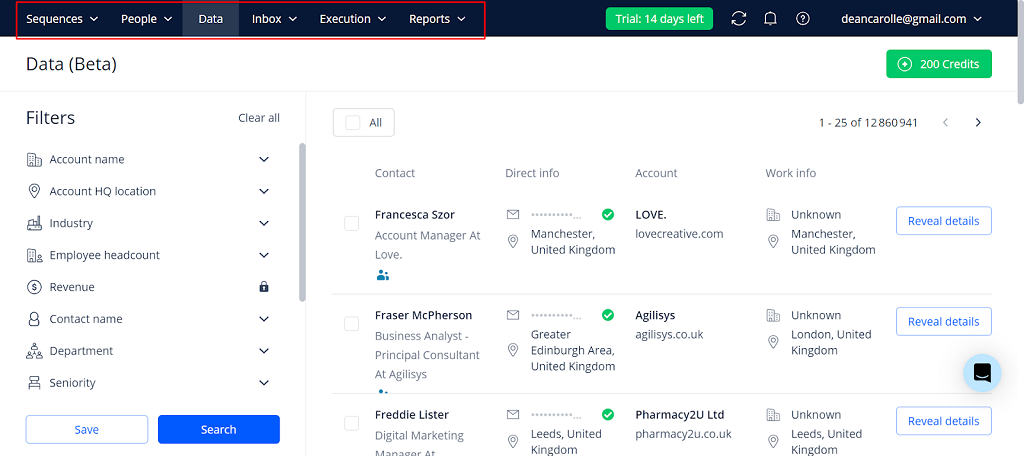
Reply.io isn’t built for fans or DMs — it’s built for outreach. But its smart reply handling is one of the most effective use cases for AI in B2B. Sales teams use it to automate and personalize responses to inbound messages, especially when scaling cold outreach or follow-ups. It uses AI to scan incoming replies and then suggest context-aware responses based on the conversation stage.
It’s not a one-message-at-a-time tool. It’s a system for ai response to text messages at scale — great for founders, SDRs, and sales-focused businesses who want to manage replies without losing the human touch.
Best for: Sales and lead-gen teams managing dozens or hundreds of conversations at once.
Pros:
- Detects lead intent and prioritizes hot replies
- Suggests smart responses based on context
- Supports outreach campaigns and workflows
- Integrates with CRMs like HubSpot and Salesforce
Cons:
- Overkill for individual creators or casual use
- UX is designed for teams, not solo operators
- Not built for NSFW or fan-based chat use
Pricing: Paid tiers only, geared toward business users and sales orgs.
Jasper AI Chat — Brand-Consistent Replies for Busy Creators
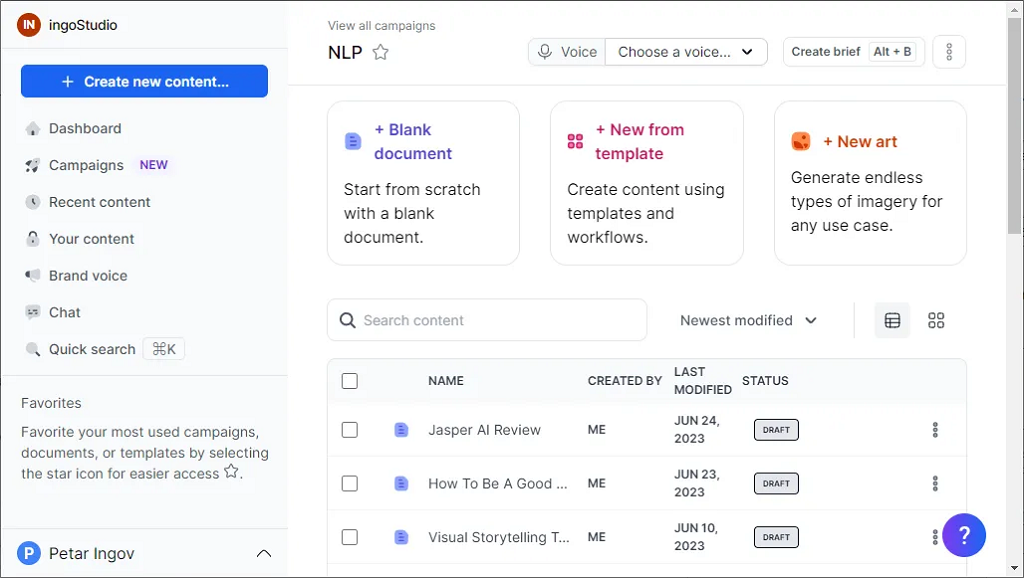
Jasper started as a content creation tool, but its AI chat module has quietly become one of the smartest options for personalized message replies — especially for businesses that care about tone and brand voice. You can train Jasper to match your writing style, use custom knowledge, and respond with a tone that feels like you — whether you’re sending a client update or replying to a fan.
Its strength lies in consistency. If you’re running a content-heavy operation or managing multiple channels, Jasper helps keep your tone aligned without sounding repetitive or forced. It’s not just an ai text reply generator — it’s a brand-safe assistant that keeps your communication sharp.
Best for: Creators, marketers, and brand managers who want replies that align with their voice, tone, and messaging.
Pros:
- Customizable voice presets and memory
- Pulls from your brand style or previous content
- Great for long-form responses or thoughtful replies
- Includes workflows for campaigns, emails, and chats
Cons:
- Less useful for live, short-form chat or NSFW
- No direct message integrations — you’ll copy/paste replies
- Premium pricing may be too much for casual use
Pricing: Premium only, with plans tailored toward marketers and business creators.
Create Your Own AI That Responds to Text with Scrile AI

Sometimes, none of the existing tools are enough. You don’t just want quick replies — you want control. You want a chat app that speaks in your voice, reacts on your terms, and earns money while it does. That’s where Scrile AI comes in. It’s not a SaaS tool. It’s a white-label development partner that builds custom AI chat solutions tailored to your brand, your model, and your audience.
Unlike off-the-shelf reply tools, Scrile AI lets you define how your AI respond to text engine works. Want emotional tone shifts? You got it. Want NSFW filters and pay-per-reply logic? Done. You’re not stuck in someone else’s interface — you’re building your own.
Scrile AI is built to support:
- Adult content creators running pay-per-message NSFW chats
- Dating coaches offering roleplay training bots
- OnlyFans-style businesses with custom tip-to-unlock responses
- Therapy and mental health startups building AI journaling companions
- Customer support teams who need branded bots that follow strict tone guidelines
- Creators and influencers monetizing private conversations or content unlocks
You decide how messages are generated, what tone they carry, and what rules they follow. Want to integrate your own payment gateway? Use your own dataset? Add custom onboarding logic or tiered response behavior? Scrile AI doesn’t just allow that — it’s built for it.
Your community, your business, your flow — powered by AI that responds to text, your way. When you’re done testing generic tools, Scrile helps you build the real thing.
Conclusion – Better Replies, Built Smarter
AI tools that reply for you aren’t just novelties anymore — they’re part of how business gets done. From inboxes to DMs, people expect speed, clarity, and a response that sounds like a real human. The right AI respond to text tool can save time, keep your tone consistent, and scale your communication without burning you out.
That’s not just a feeling — it’s backed by adoption numbers. A recent guide on customer service auto-replies cites data from Heymarket showing how widespread automated responses already are in business messaging.
“In fact, 89% of businesses use auto-replies to manage customer expectations, and tailored messages significantly enhance engagement.”
— Sobot, “50 Automatic Reply Customer Service Examples”
When almost nine out of ten businesses rely on auto-replies, the real differentiator isn’t whether you automate — it’s how smart and on-brand those replies feel. That’s where the tools in this list — and especially a custom Scrile AI setup — turn basic automation into a real competitive edge.
But automation only goes so far when you’re boxed into someone else’s design. What happens when you need replies that reflect your brand, your tone, or even your industry rules? That’s where control matters more than convenience.
Scrile AI gives you that control. You don’t get a basic chatbot. You get your own branded reply system — custom logic, tone presets, monetization tools, and even NSFW capability if that’s your space. No limits. No cookie-cutter templates. Just an engine that responds exactly how you want it to.
So if you’re done testing generic tools and ready to build something that’s truly yours, contact the Scrile AI team today and start building your AI respond to text solution from the ground up.
Polina Yan is a Technical Writer and Product Marketing Manager, specializing in helping creators launch personalized content monetization platforms. With over five years of experience writing and promoting content, Polina covers topics such as content monetization, social media strategies, digital marketing, and online business in adult industry. Her work empowers online entrepreneurs and creators to navigate the digital world with confidence and achieve their goals.

by Polina Yan
Ever wished for a personal assistant who never needs sleep, never forgets, and always has the right answer? In 2025, the best AI assistants are stepping into this role, offering virtual support that goes far beyond basic automation. These digital helpers manage everything from scheduling meetings and setting reminders to generating creative content and even managing smart home devices.
AI assistants are no longer just for tech enthusiasts. They have become essential tools for businesses, creators, and everyday users who want to save time and boost productivity. Whether you need help organizing your day, interacting with customers, or simply setting the perfect ambiance at home, there’s an AI assistant designed to make life easier.
AI assistants like ChatGPT, Claude or Gemini feel so natural to use that it’s easy to forget how new this technology actually is. Large research firms now describe this moment as a turning point in how people communicate with software.
“ChatGPT and its competitors have captured the imagination of people around the world in a way AlphaGo did not, thanks to their broad utility—…” — McKinsey & Company
When even conservative analysts highlight the “imagination” and broad utility of these tools, it reinforces that AI assistants are not a niche experiment anymore. They’re becoming a standard interface for search, content creation, and everyday problem-solving — which is exactly why choosing the right assistant in 2025 really matters.
In this article, we’ll explore the top AI assistants of 2025. We’ll look at big names like Google Assistant, Amazon Alexa, and Apple Siri, as well as innovative tools like ChatGPT, Motion AI and custom solutions from Scrile AI. Each assistant brings unique features to the table, making it easier to find the perfect fit for your needs—whether for personal tasks or professional productivity. Let’s find out what makes the best AI assistant and discover which one might become your new favorite virtual helper.
Top 7 AI Assistants in 2025 – Quick Comparison
| Assistant | Best For | Strengths | Limitations | Ecosystem Fit |
|---|
| Google Assistant | Everyday + work routines | Google Workspace & smart home integration, proactive suggestions | Best inside Google ecosystem | Google users |
| Amazon Alexa | Smart home + retail tasks | Huge device network, “Skills” marketplace, shopping & automation | Less natural conversation; retail bias | Amazon ecosystem |
| Apple Siri | Apple device owners | Seamless iOS/macOS integration, HomeKit control, messaging | Limited outside Apple hardware | Apple ecosystem |
| Microsoft Cortana | Office productivity | Deep Microsoft 365 integration, meeting scheduling, smart suggestions | Phasing out for consumer use | Windows/Office users |
| Samsung Bixby | Samsung smart devices | Strong SmartThings control, TV/phone integration | Weak app ecosystem, limited global reach | Samsung ecosystem |
| ChatGPT (OpenAI) | Content & communication | Human-like text replies, content creation, chatbot support | No native voice/device control | Cross-platform |
| Motion AI | Productivity & scheduling | Smart auto-scheduling, task priorities, Slack/Calendar integration | Focused on work tasks only | Teams & professionals |
What is an AI Assistant?

An AI assistant is a smart digital helper designed to manage tasks, answer questions, and streamline both personal and professional activities. These virtual assistants use technologies like natural language processing and machine learning to understand voice commands, manage schedules, set reminders, and control smart home devices.
The best AI personal assistants can integrate with apps and services, providing hands-free convenience for busy professionals and everyday users alike. They excel in business environments, helping with tasks like email management, meeting scheduling, and data organization. On creator platforms and social media, they assist with content generation and audience engagement.
The rise of best AI virtual assistants has transformed how we interact with technology, offering tailored solutions for work productivity and simplifying everyday life. Whether managing a to-do list, setting up a smart home, or enhancing business communications, AI assistants bring efficiency and ease to daily routines.
This isn’t just a new label for old productivity tools. Companies that work with virtual assistants every day note that AI has already reshaped how these assistants feel and what they can realistically handle.
“The impact of AI on virtual assistant tools has been transformative, bringing about significant enhancements in user experience, productivity…” — Brickwork India
Thinking about AI assistants as a “transformative” layer helps frame the rest of this guide: you’re not just picking a chat app, you’re choosing infrastructure for how you plan, communicate and work. The tools we review below — from mainstream assistants to custom solutions — only make sense when you see them through this long-term lens.
Benefits of Using an AI Assistant
AI assistants bring many benefits to both personal and professional life. They help users stay organized, manage tasks efficiently, and maintain a consistent communication style in business settings. Here are the top advantages of using an AI personal assistant for business and everyday use:
- Increases Productivity: AI assistants handle repetitive tasks like scheduling meetings, sending reminders, and organizing calendars. This automation frees up time for more important activities.
- Enhances Time Management: These tools provide smart reminders, integrate with calendars, and help manage daily routines smoothly. They reduce the chances of missed appointments or deadlines.
- Ensures Consistency: Businesses often struggle to maintain a uniform brand voice across all communications. An AI assistant helps keep messages consistent, whether it’s in emails, social media posts, or customer support responses.
- Practical Example: A content creator using a best personal assistant AI can manage fan interactions on social media more efficiently. The assistant can generate quick responses to comments, draft messages, and even schedule posts to maintain regular engagement.
- Versatile Uses: With so many AI assistant names available, choosing who is the best AI assistant depends on specific needs. Some excel at managing business tasks, while others focus on personal organization or creative support.
AI assistants are more than just digital helpers. They act as smart partners that enhance productivity, improve communication, and simplify day-to-day tasks. Whether at work or home, these tools adapt to user needs and make life easier.
From a business perspective, the real test for any AI assistant is simple: does it actually give people back meaningful time? Independent analysts emphasize that the biggest gains appear when assistants take over repetitive, low-value work that clogs calendars.
“AI assistants significantly reduce the burden of routine and repetitive tasks, freeing employees to focus on higher-value work.” — Enterprise Management Associates (EMA)
This is exactly the shift you’re aiming for when you roll out AI assistants across a team or build your own: move routine, rules-based tasks to the AI, and let humans focus on strategy, creativity, and relationships. As you compare the tools in this article — including custom options like Scrile AI — keep that productivity test in mind.
Top 7 AI Assistant Tools in 2025
AI assistants are transforming how we manage tasks, automate routines, and enhance productivity. Let’s explore the first set of top AI assistants making waves in 2025:
Google Assistant
Google Assistant is a powerhouse in the AI assistant world. It offers integration to Google Workspace and smart home devices. With voice commands, one can schedule a reminder, schedule a meeting, and manage routine. For instance, one can easily command, “Hey Google, schedule a meeting at 3 PM,” and it will be scheduled to the calendar. It also offers personalized suggestion like an early leave reminder to catch an appointment based on traffic information. Its usage both home and office makes it an option to be considered by the majority.
Amazon Alexa

Amazon Alexa has retail and home automation functions. It connects to various smart devices to control via voice commands lights to home defense systems. Alexa is also an easy tool to use to manage shopping lists, remind one about appointments, and automate office operations. Small businesses employ Alexa to manage stock quantity, orders handling, and office communications automation. Alexa’s “Skills” option offers flexibility to enable users to use the use to suit some specific purposes, be it office or home.
Apple Siri
Siri is an essential AI partner to the user in the Apple ecosystem. It offers seamless integration to the devices manufactured by Apple, thereby making iPhones, iPads, Macs, and smart home devices voice-controlled through the integration through the use of HomeKit. It offers users routine productivity through the sending of messages, reminder creation, and control of smart home devices. It can be used to send a message, play a song, or control the thermostat. The seamless integration that it offers to the other Apple programs and devices makes the usage seamless.
Microsoft Cortana
Microsoft Cortana has been designed specifically to suit office users. It fully supports Windows integration and Microsoft 365. Hence, using it within an office is the best option. Cortana supports the creation of meeting schedules, the creation of reminders, and the organization of the task. Cortana can compose emails and also offer smart suggestions during the meeting. For instance, a professional can instruct Cortana to schedule the day, and it will create a scheduled calendar based on the entries and priority. Its productivity-related functions enable Cortana to be an efficient tool to enhance the productivity of the work.
Samsung Bixby
Samsung Bixby is the most intelligent to be employed by users under the Samsung ecosystem. It offers robust voice control of Samsung devices like smartphones, tablets, smart TVs, and smart home devices. Samsung Bixby can be used to automate the sending of messages, calling, and controlling smart devices through basic voice commands. As an example, one can easily employ the command, “Turn off the lights, Bixby,” and the command will be executed. It supports Samsung’s SmartThings app that offers easier control of devices through one interface.
ChatGPT by OpenAI

who is the best ai assistant
Unlike traditional voice assistants, ChatGPT is a powerful tool for text-based interactions. It excels in content generation, answering questions, and managing online interactions. Many businesses and creators use ChatGPT as a virtual assistant to draft responses, generate content ideas, and engage with audiences. For instance, a social media manager might use ChatGPT to create thoughtful replies to community comments or to brainstorm creative post ideas. It’s also popular for creating automated chatbots that provide human-like customer support.
Motion AI
Motion AI is an efficient tool that supports users to organize schedules, manage work, and be more efficient. It offers the possibility to add smart scheduling, task organization, and reminder automation. As an artificial tool to professional users, Motion AI can help users organize the meeting calendar, assign priority to the tasks, and streamline the workflow. The best way to understand how Motion AI functions is the integration that it offers to use Google Calendar and Slack to automate the routine to allow teams to work strategically.
Which AI Assistant is Right for You?
Choosing the best AI assistant will be a case of one’s specific needs. Google Assistant and Alexa are best used to control the smart home. Siri and Bixby are best used within each respective ecosystem but Cortana is best used within the office. ChatGPT will create sophisticated writing but Motion AI produces the best productivity and task management. Each one has something to bring to the table to create the best pairing to use within the home and the office.. However, there is also another solution if you need something created just for you.
Why Scrile AI is The Best Solution for Building Your Own AI Assistant

Scrile service offers a robust service for creating customized AI assistants tailored to unique business needs. Unlike generic tools, Scrile AI allows businesses to develop AI personal assistants for business or personal use with features and interactions that align perfectly with their brand and goals.
One of the biggest advantages of Scrile AI is its ability to deliver beyond off-the-shelf tools. Instead of using a standard AI assistant, businesses can design solutions specifically for their industry. Scrile solutions support a wide range of markets, including e-commerce, education, tech services, and niche sectors like creator platforms, influencer accounts, dating sites, social media, and adult websites. This adaptability makes it a versatile choice for businesses aiming to integrate a best personal assistant AI that can handle complex interactions.
Real-world adaptability is another strength of Scrile AI solutions. The AI assistants developed through its platform are not static; they learn from interactions, evolve with the business, and remain relevant over time. For example, a business could create an AI assistant that not only automates communication but also provides personalized responses and enhances user engagement. This assistant might manage customer inquiries, support sales teams, or automate social media interactions—showing why Scrile AI is a top choice for building a dynamic and effective AI assistant.
If you’re looking for the best AI assistant for your business, Scrile offers the tools and flexibility to create an assistant that meets your exact needs. It is the ideal platform for those who want a tailored solution instead of a one-size-fits-all approach. Explore how Scrile can help you develop a personalized AI assistant that keeps your brand ahead of the competition.
Off-the-Shelf AI Assistants vs. Scrile AI
| Option | Branding & Ownership | Flexibility | Monetization | Best Fit |
|---|
| Standard AI Assistants (Google, Alexa, Siri, etc.) | Vendor-controlled | Fixed features, limited customization | None | General users & households |
| Scrile AI (Custom Assistant) | 100% branded & owned | Fully customizable: text, voice, NSFW/SFW, CRM hooks | Built-in: subs, tips, PPV | Businesses, creators, niche platforms |
Conclusion
The best AI assistant can make a real difference in both personal and business life. These digital helpers boost productivity, streamline tasks, and offer valuable support in everyday routines. Whether you’re using Google Assistant for smart home control, Amazon Alexa for managing e-commerce tasks, or ChatGPT for content generation, each tool brings unique benefits to the table.
For businesses looking to go beyond generic solutions, Scrile AI offers a unique opportunity. Instead of settling for a standard AI personal assistant, you can develop a custom assistant tailored to your specific needs. Scrile’s solutions provide all the tools required to build an AI that aligns perfectly with your brand and industry. This flexibility is ideal for companies in niche markets or those with specialized communication needs.
If you’re ready to create a personalized AI assistant that fits your exact needs, explore Scrile AI tools today. It’s the first step towards building a smarter, more efficient digital assistant that can keep your business ahead of the curve.
Polina Yan is a Technical Writer and Product Marketing Manager, specializing in helping creators launch personalized content monetization platforms. With over five years of experience writing and promoting content, Polina covers topics such as content monetization, social media strategies, digital marketing, and online business in adult industry. Her work empowers online entrepreneurs and creators to navigate the digital world with confidence and achieve their goals.

by Polina Yan
Scan a T-shirt. Watch it move. Trigger a sound. Unlock a message. Augmented reality is already sewn into fabric, printed on hoodies, embedded in patches. It’s not hype. It’s already out there — and it works.
The question now is simple: how to make augmented reality clothing that doesn’t feel like a cheap trick. Something that sticks. Something people want to wear, share, and come back to.
Designers are experimenting with motion graphics on sleeves. Educators use AR shirts to show anatomy in real time. Streetwear drops go viral because a camera reveals something the naked eye can’t. These aren’t concepts. They’re products in the wild.
This article breaks it down. The gear you need. The process, step by step. How brands are doing it. What’s actually worth building. And how anyone with a strong idea — not just major labels — can start putting interactive clothing into the world.
What Is Augmented Reality Clothing?
Augmented reality clothing refers to garments that trigger digital visuals or interactions when viewed through a phone or AR glasses. It could be an animation mapped to a printed design, a video layered on a logo, or 3D content that appears to hover just above the fabric.
The experience depends on how the garment is designed. Some respond to image markers or patterns, others use QR codes or embedded chips. Once scanned, they activate extra content: moving graphics, audio, virtual buttons, or full-screen scenes. It’s a way to add motion and story to physical products without screens.
Augmented reality try on clothes refers to digital fitting tools that let users preview how a garment might look, often using a mobile camera or smart mirror. Meanwhile, augmented reality clothing fitting uses body tracking and virtual overlays to simulate real-time fit, helping shoppers make better decisions without needing a physical fitting room.
This technology blends novelty with function. It helps brands turn clothing into interactive media. Artists use it to create immersive installations. Educators apply it to visualize anatomy, geography, or science in classrooms. For independent creators, it opens a way to sell not just fabric, but digital storytelling through clothing.
Real-World Use
Fashion retailers are already testing and deploying AR at scale. H&M launched AR try-ons through Snapchat, allowing users to select and preview outfits directly through their phones.
Other examples include:
- Music merch that unlocks unreleased tracks
- Event tees that act as digital passes or memory vaults
- Kids’ clothing that tells interactive stories
- Collectible drops tied to NFTs or limited-edition content
AR adds a second layer to clothing. It gives people a reason to look again — not just wear it once and forget.
The Tech Behind AR Clothing

Before anything looks cool through a camera, it has to be built right. How to make augmented reality clothing depends on a few moving parts: visuals, markers, motion tracking, and the software that ties it all together.
Start with design. Most creators use 3D modeling tools like Blender or Marvelous Designer to shape digital garments or visual elements. These can range from simple pop-up text to full characters animated over the shirt.
Then comes delivery. There are two main approaches:
- Marker-based AR: A printed image or logo on the garment triggers the digital layer. This is the most common approach for T-shirts and jackets.
- Markerless AR: The app tracks the body or clothing without needing a printed reference. It’s trickier to build but creates a smoother experience.
To keep the visual stable while the person moves, the system uses AI tracking. That includes face and body detection, pose estimation, and sometimes depth mapping. These tools help the content stay “stuck” to the right part of the garment.
Apps come in two formats:
- WebAR: Runs directly in the browser. No download needed. Easier to access, but with some performance limits.
- Native mobile apps: More powerful and smoother but require users to install something.
Platforms like Unity, 8thWall, Vuforia, and Spark AR handle the development layer. Each has different strengths. For example, Spark is popular for filters, while Unity gives full control over interaction and animation. This is where your augmented reality clothing app takes shape.
From Fabric to Framework
To connect real garments with digital content, creators use:
- QR codes stitched into tags or labels
- Printed markers blended into the graphic design
- Image recognition that links a shirt’s design to a hidden animation
- Digital twins, where each physical item has a virtual copy
These methods are what turn regular AR clothes into experiences. Whether you’re building immersive merch, educational tools, or virtual reality clothing, everything starts with a decision: what does the shirt unlock, and how does it know when to do it?
Step-by-Step: How to Make Augmented Reality Clothing

Creating an interactive garment looks complex from the outside, but the workflow becomes clear once you break it into stages. Anyone exploring how to make augmented reality clothing will follow a path that moves from concept to design and then into development, testing, and launch. Each step shapes the final feel of the product.
Step 1 — Define Your Concept
Start with a simple question: what should the clothing activate? Some creators build story-driven animations. Others focus on music, product information, or collectibles. The concept guides the style of the artwork, the type of animation, and the platform you will use. It also helps identify the audience. Kids, festival-goers, sports fans, or educators respond to very different visual cues. A clear direction keeps the project from drifting.
Step 2 — Design the Garment
The physical item needs to work with the digital layer. Choose a spot for the trigger image that stays visible when the garment is worn. That spot might be the chest, sleeve, or back panel. A detailed illustration, logo, or symbol often works best because it gives the tracking system enough information to lock onto. Think of the design as a stage: clean shapes help the camera recognize the target quickly.
Step 3 — Choose the Platform
The engine you select shapes the development process. Unity is popular for animated scenes with movement and depth. WebAR tools allow users to scan garments without installing an app. Meta Spark works well for camera-first experiences shared on social networks. Each option has its own workflow, so it’s best to match the tool to your idea rather than forcing the idea into the tool.
Step 4 — Build the Digital Layer
This is where the visual content takes form. It can be a short animation, a looping 3D object, a sound-reactive graphic, or a simple text reveal. The digital layer should enhance the design rather than overwhelm it. Clear timing, readable motion, and smooth interaction give the effect depth without confusing the user.
Step 5 — Link the Content
After the animation is ready, connect it to the chosen marker. Platforms offer tools that map digital visuals onto an image so the scene appears in the right place every time. Good alignment is essential. Poor mapping makes the AR look shaky.
Step 6 — Test Across Devices
Phones differ in camera quality and performance. Test on as many devices as possible. Check tracking stability, lighting conditions, and how the AR reacts when the person moves or turns.
Step 7 — Launch and Promote
Once everything feels solid, release the product. Share demos, record try-on clips, create hashtags, and encourage your community to post their reactions. AR clothing spreads fast because people enjoy showing it off.
AR Clothing Brand Examples and Ideas
There’s no shortage of real brands proving that AR clothing isn’t a gimmick — it’s a tool that gets attention, tells stories, and drives engagement. If you’re serious about how to make augmented reality clothing, it helps to study what others have already done and why it worked.
Here are a few standout examples from both big players and smaller experiments:
- H&M ran AR try-ons through Snapchat. Pick an outfit, open your camera, see it mapped on your body. It worked inside the app and on the H&M website. No extra hardware. No separate app. Just scroll, scan, and try.
- Red Bull dropped shirts that launch interactive games. You scan the chest print, it opens a branded AR scene with characters, effects, movement — all tied into their “Wiiings” campaign. Merch became the controller.
- Pepsi used AR on bottles and apparel. Some shirts unlocked video messages. Others worked as part of limited-edition drops tied to music events.
- Zalando took the sizing headache and turned it into an AR preview. You could stand in front of your phone and check how a jacket fits. It didn’t just show the product — it helped you decide.
- IKEA went heavy on product AR, then let that same idea spill into branded clothing and displays. The logic was the same: place the thing in your space. Let people imagine owning it before they buy.
- Artists are doing this too. Shirts that show moving sculptures. Logos that turn into faces. Generative graphics triggered by your camera.
- Some creators are pairing this with NFTs. The shirt is real, but the AR layer is a digital twin with unlockable perks.
If you’re thinking about how to make augmented reality clothing, don’t just chase effects. Figure out what the shirt gives people once they scan it.
Build Your Own AR Fashion Brand

The tech matters, but the branding decides whether anyone cares. A clean marker won’t save a weak idea. People remember how something looks, feels, and moves — both in their hands and through their camera.
Start with your visual identity. Your logo, colors, graphic style — all of it has to read clearly in print and on screen. Some designs break apart once scanned. Fine lines blur. Busy backgrounds confuse trackers. Design with contrast. Test at different sizes. Hold the shirt up to a camera and move it around. If the AR effect only works when the shirt is perfectly still, fix it.
The user experience goes beyond what the app shows. Think about lighting. Think about front-facing vs. rear cameras. Make sure your content works on both high-end and older phones. Not everyone scans your work with a brand-new iPhone. The real world is messy. Build for it.
Now: how do you sell it?
You don’t need to launch with 30 pieces. A single strong design, dropped in a small run, can do more than a full collection. Start with a theme. Tie it to a moment, a message, or a story. Offer it in a limited batch. Set up a basic online store or collaborate with a brand that already has reach.
AR gives you room to do things printed clothing can’t. That’s your edge. Don’t waste it with empty effects. Let the shirt unlock something worth coming back for. A visual. A sound. A memory. A reason to care.
Develop Your Own AR Product with Scrile Custom Development Services

Building something that actually works takes more than a template. You need a team that understands how to turn your concept into a full product — not just an effect. That’s where Scrile comes in.
Scrile isn’t a platform. It’s a custom development service. That means you don’t adapt your idea to a preset tool. We build the tool around your idea.
If you’re serious about how to make augmented reality clothing, and you’re ready to move from a test file to a live product, this is the stage to get in touch.
Here’s what Scrile can develop for you:
- Virtual try-on apps that simulate fit and style using body tracking
- Marker-based AR clothing systems that trigger animations, games, or product info
- Backends for AR commerce, including user analytics, content control, product syncing, and real-time data
- Admin tools for managing drops, updating designs, and tracking campaign performance
- Custom viewer interfaces — browser-based, app-integrated, or branded standalone
You bring the visual direction, the brand story, or even just a rough sketch. Scrile handles the architecture, the integrations, and the features needed to bring it to life.
We don’t offer one-size-fits-all packages. Every build is shaped around your goals, your stack, and your users. Whether you need a lightweight demo or a full ecosystem ready to scale, we work with you to make it happen.
Interactive clothing deserves interactive thinking. If the idea is ready, Scrile’s the partner that knows how to build it right.
Conclusion
AR clothing is functional design with digital depth. It’s built to be scanned, moved through space, and talked about. Every piece becomes more than its print. It becomes part of the story you’re telling.
Anyone with a clear vision can start building. The tools are out there. The workflow is manageable. What matters is choosing the right team to put the parts together and make sure it works where it counts — in someone’s hands, through their lens, on their screen.
Scrile builds full custom systems for interactive products like AR clothing. From visual triggers to app frameworks, from backend logic to user experience — everything is built to match your idea, not restrict it.
You can launch a working product, bring it to market, and grow it into something bigger. Start by exploring how Scrile Custom Development Services can help you build a real AR product from the ground up.
FAQ
How do you make an AR T-shirt?
Start with a clear idea. Decide what the shirt should trigger — animation, sound, video, or something else. Design the graphic so it works as a visual marker. Tools like Unity or WebAR platforms let you build the digital content and link it to the image. Test it on multiple devices. Once everything tracks smoothly, publish it and share your launch with the audience you’re building for.
Does H&M use AR in their clothing?
Yes. H&M partnered with Snap to create AR try-on experiences. Users can select clothes, see how they fit, and share the look, all through their phone’s camera. It works in both the Snapchat app and the H&M mobile app.
What companies are using AR for branding or clothing?
Brands like Red Bull, Pepsi, IKEA, Zalando, Philips, Walmart, and even Arsenal FC use AR in different ways — from merch drops and product previews to interactive ads and digital collectibles.
Polina Yan is a Technical Writer and Product Marketing Manager, specializing in helping creators launch personalized content monetization platforms. With over five years of experience writing and promoting content, Polina covers topics such as content monetization, social media strategies, digital marketing, and online business in adult industry. Her work empowers online entrepreneurs and creators to navigate the digital world with confidence and achieve their goals.



![]()
![]()



























































